Paul van Yperen's Blog, page 351
March 22, 2016
Imported from the USA: Yul Brynner
Yul Brynner (1920–1985), famous for his completely bald head, was a Russian-born United States-based film and stage actor. He was best known for his portrayal of King Mongkut of Siam in the Rodgers and Hammerstein musical The King and I. He played the role 4,625 times on stage and won two Tony Awards. For the film version, The King and I (Walter Lang, 1956), he also won the Academy Award. The following decades, he starred in a wide range of roles from Egyptian pharaohs to Western gunfighters, both in Hollywood and European films.
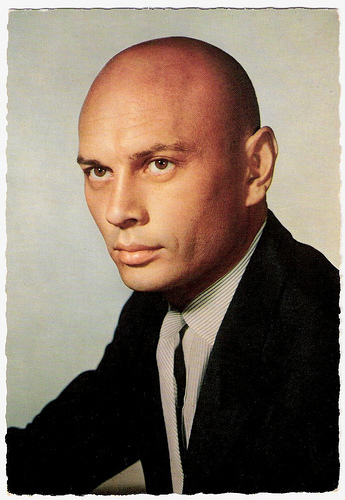
French postcard by E.D.U.G., no. 45 (ca. 1960). Photo: Sam Levin.
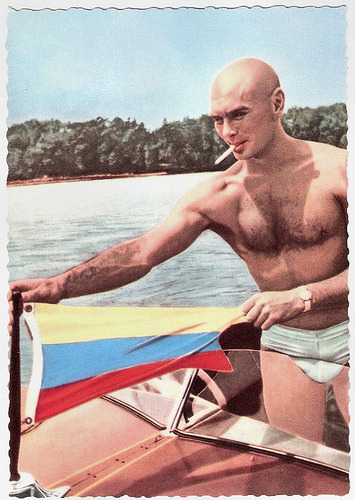
German postcard by Ufa, Berlin-Tempelhof, no. CK-61. Photo: Herbert Fried / Ufa.
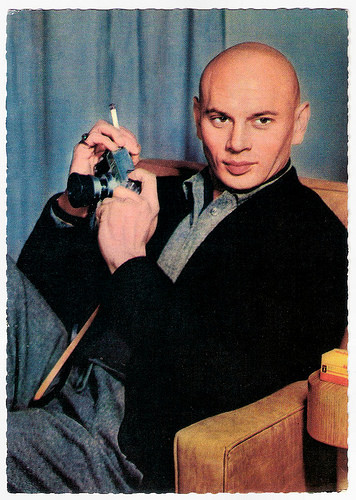
German postcard by ISV, no. A 54. Photo: 20th Century Fox. Publicity still for Anastasia (Anatole Litvak, 1956).
King Mongkut
Yul Brynner was born Yuly Borisovich Briner (Russian: Юлий Борисович Бринер) in Vladivostok, Far Eastern Republic (present-day Vladivostok, Russia) in 1920. His father, Boris Yuliyevich Briner, was a mining engineer and inventor. Brynner's mother, Marousia Dimitrievna (née Blagovidova), came from the Russian intelligentsia and studied to be an actress and singer. In 1923 his father fell in love with an actress, Katya Kornukova, at the Moscow Art Theatre, and soon after abandoned his family.
Yul's mother took him and his sister, Vera, to Harbin, China, where they attended a school run by the YMCA. In 1932, fearing a war between China and Japan, she took them to Paris. Brynner played his guitar in Russian nightclubs in Paris, sometimes accompanying his sister, playing Russian and Roma songs. He trained as a trapeze acrobat and worked in a French circus troupe for five years, but after sustaining a back injury, he turned to acting. In 1940, speaking little English, he and his mother emigrated to the United States, where his sister already lived.
During World War II, Brynner worked as a French-speaking radio announcer and commentator for the US Office of War Information, broadcasting propaganda to occupied France. At the same time, he studied acting in Connecticut with the Russian teacher Michael Chekhov. He toured the country with Chekhov's theatrical troupe. Brynner’s first Broadway performance was a small part in William Shakespeare's Twelfth Night (1941). Brynner found little acting work during the next few years. He did some modelling work and was photographed nude by George Platt Lynes.
Brynner's first marriage was to actress Virginia Gilmore in 1944, and soon after he began working as a director at the new CBS television studios, directing Studio One, among other shows. In 1946, he co-starred in a production of Lute Song with Mary Martin. He made his film debut in the Film Noir Port of New York (László Benedek, 1949) with Scott Brady.
The next year, at the urging of Mary Martin, he auditioned for Richard Rodgers and Oscar Hammerstein II's new musical, The King and I (1951). Brynner became an immediate sensation. The part of King Mongkut would become his most famous role which he played 4625 times on stage. Brynner shaved his head for his role and continued to shave his head for the rest of his life. Brynner's shaven head was unusual at the time, and his striking appearance helped to give him an exotic appeal. He won Tony Awards for both the first production in 1951 as for the Broadway revival in 1985.
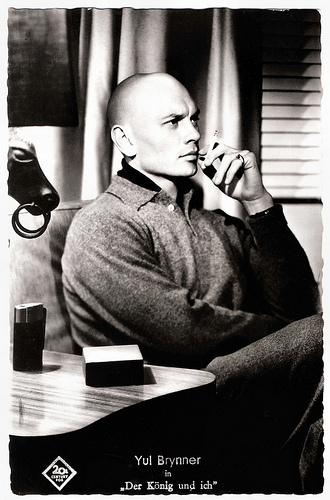
German postcard by Kolibri-Verlag, Minden-Westf., no. 2392. Photo: 20th Century Fox. Publicity still for The King and I (Walter Lang, 1956).
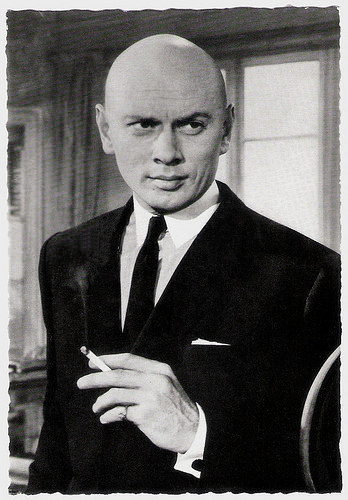
German postcard by WS-Druck, Wanne-Eickel, no. 177. Photo: 20th Century Fox. Publicity still for Anastasia (Anatole Litvak, 1956).
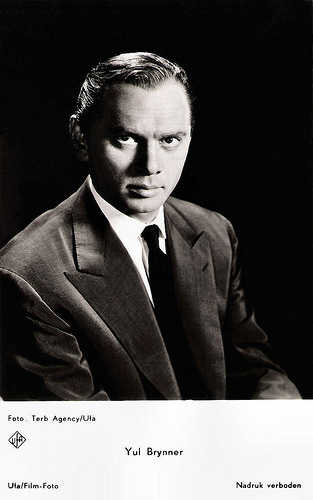
Dutch postcard by Gebr. Spanjersberg N.V., Rotterdam, no. 1274. Photo: Terb Agency / Ufa.
Gunslinger robot
In 1956, Yul Brynner also appeared in the film version, The King and I (Walter Lang, 1956), opposite Deborah Kerr. For his role he won an Academy Award as Best Actor. Brynner is one of only nine people who have won both a Tony Award and an Academy Award for the same role. He quickly gained superstar status with his roles as Pharaoh Rameses II opposite Charlton Heston's Moses in the blockbuster The Ten Commandments (Cecil B. DeMille, 1956) and as General Bounine in the historical drama Anastasia (Anatole Litvak, 1956) opposite Ingrid Bergman .
He made the 'Top 10 Stars of the Year' list in both 1957 and 1958. He co-starred with Lee J. Cobb in The Brothers Karamazov (Richard Brooks, 1958), based on Fyodor Dostoevsky's novel. Brynner starred as Solomon opposite Gina Lollobrigida in the epic Solomon and Sheba (King Vidor, 1959), and as Chris Adams in the Western The Magnificent Seven (John Sturges, 1960) with Eli Wallach, Steve McQueen, and Horst Buchholz . The film was a box office disappointment in the United States, but proved to be such a smash hit in Europe that it ultimately made a profit.
Over the next two decades, Brynner appeared in more than 40 other films. In the early 1960s, he starred in Taras Bulba (J. Lee Thompson, 1962) and Kings of the Sun (J. Lee Thompson, 1963). He co-starred with Marlon Brando in Morituri (Bernhard Wicki, 1965), and with Katharine Hepburn in The Madwoman of Chaillot (Bryan Forbes, 1969).
In Europe, Brynner appeared in the Anglo-French war film Triple Cross (Terence Young, 1966) with Christopher Plummer and Romy Schneider , in the Yugoslavian partisan film Bitka na Neretvi/Battle of Neretva (Veljko Bulajić, 1969) and the British thriller The File of the Golden Goose (Sam Wanamaker, 1969). He also appeared in drag as a torch singer in an unbilled role in the Peter Sellers comedy The Magic Christian (Joseph McGrath, 1969).
In the following decade, he played a gunslinger robot in the Science fiction Western-thriller Westworld (Michael Crichton, 1973) and returned in its sequel Futureworld (Richard T. Heffron, 1976). Among his final feature film appearances were the titular role in The Ultimate Warrior (Robert Clouse, 1975) and his role opposite Barbara Bouchet in the Italian film Con la rabbia agli occhi/Death Rage (Antonio Margheriti, 1976).
Later in life, Brynner was an active photographer and wrote two books. His daughter Victoria put together Yul Brynner: Photographer a collection of his photographs of family, friends, and fellow actors, as well as those he took while serving as a UN special consultant on refugees. Brynner wrote Bring Forth the Children: A Journey to the Forgotten People of Europe and the Middle East (1960), with photographs by himself and Magnum photographer Inge Morath, and The Yul Brynner Cookbook: Food Fit for the King and You (1983).
Yul Brynner died of lung cancer in 1985, in New York City. He married four times. His first three marriages ended in a divorce. Brynner had a long affair with Marlene Dietrich , who was 19 years his senior, beginning during the first production of The King and I in 1951. He fathered three children and adopted two. His oldest son Rock wrote a book about his father and his family history titled Empire and Odyssey: The Brynners in Far East Russia and Beyond (2006).
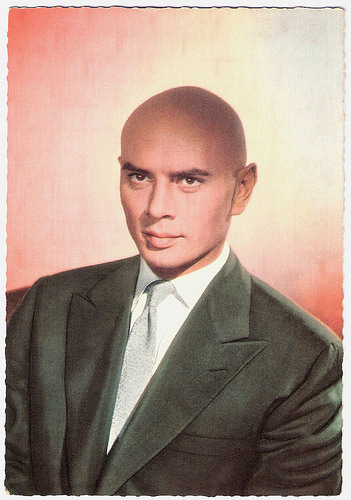
German postcard by ISV, no. B 20. Photo: MGM. Publicity still for The Brothers Karamazov (Richard Brooks, 1958).
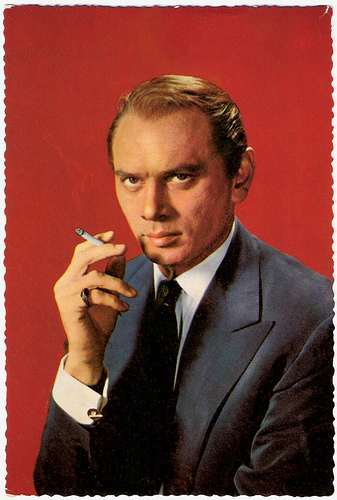
Spanish postcard by Sobernanas / Damm, no. 12.007. Photo: 20th Century Fox. Publicity still for The Sound and the Fury (Martin Ritt, 1959).
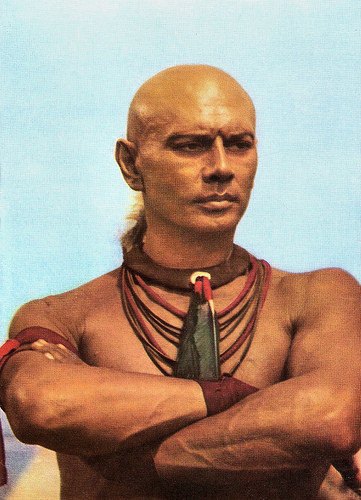
Romanian postcard by Casa Filmului Acin. Publicity still for Kings of the Sun (J. Lee Thompson, 1963).
Trailer The King and I (1956). Source: Ageless Trailers (YouTube).
Trailer Westworld (1973). Source: Ron Flaviano (YouTube).
Source: (IMDb), Wikipedia and .

French postcard by E.D.U.G., no. 45 (ca. 1960). Photo: Sam Levin.

German postcard by Ufa, Berlin-Tempelhof, no. CK-61. Photo: Herbert Fried / Ufa.

German postcard by ISV, no. A 54. Photo: 20th Century Fox. Publicity still for Anastasia (Anatole Litvak, 1956).
King Mongkut
Yul Brynner was born Yuly Borisovich Briner (Russian: Юлий Борисович Бринер) in Vladivostok, Far Eastern Republic (present-day Vladivostok, Russia) in 1920. His father, Boris Yuliyevich Briner, was a mining engineer and inventor. Brynner's mother, Marousia Dimitrievna (née Blagovidova), came from the Russian intelligentsia and studied to be an actress and singer. In 1923 his father fell in love with an actress, Katya Kornukova, at the Moscow Art Theatre, and soon after abandoned his family.
Yul's mother took him and his sister, Vera, to Harbin, China, where they attended a school run by the YMCA. In 1932, fearing a war between China and Japan, she took them to Paris. Brynner played his guitar in Russian nightclubs in Paris, sometimes accompanying his sister, playing Russian and Roma songs. He trained as a trapeze acrobat and worked in a French circus troupe for five years, but after sustaining a back injury, he turned to acting. In 1940, speaking little English, he and his mother emigrated to the United States, where his sister already lived.
During World War II, Brynner worked as a French-speaking radio announcer and commentator for the US Office of War Information, broadcasting propaganda to occupied France. At the same time, he studied acting in Connecticut with the Russian teacher Michael Chekhov. He toured the country with Chekhov's theatrical troupe. Brynner’s first Broadway performance was a small part in William Shakespeare's Twelfth Night (1941). Brynner found little acting work during the next few years. He did some modelling work and was photographed nude by George Platt Lynes.
Brynner's first marriage was to actress Virginia Gilmore in 1944, and soon after he began working as a director at the new CBS television studios, directing Studio One, among other shows. In 1946, he co-starred in a production of Lute Song with Mary Martin. He made his film debut in the Film Noir Port of New York (László Benedek, 1949) with Scott Brady.
The next year, at the urging of Mary Martin, he auditioned for Richard Rodgers and Oscar Hammerstein II's new musical, The King and I (1951). Brynner became an immediate sensation. The part of King Mongkut would become his most famous role which he played 4625 times on stage. Brynner shaved his head for his role and continued to shave his head for the rest of his life. Brynner's shaven head was unusual at the time, and his striking appearance helped to give him an exotic appeal. He won Tony Awards for both the first production in 1951 as for the Broadway revival in 1985.

German postcard by Kolibri-Verlag, Minden-Westf., no. 2392. Photo: 20th Century Fox. Publicity still for The King and I (Walter Lang, 1956).

German postcard by WS-Druck, Wanne-Eickel, no. 177. Photo: 20th Century Fox. Publicity still for Anastasia (Anatole Litvak, 1956).

Dutch postcard by Gebr. Spanjersberg N.V., Rotterdam, no. 1274. Photo: Terb Agency / Ufa.
Gunslinger robot
In 1956, Yul Brynner also appeared in the film version, The King and I (Walter Lang, 1956), opposite Deborah Kerr. For his role he won an Academy Award as Best Actor. Brynner is one of only nine people who have won both a Tony Award and an Academy Award for the same role. He quickly gained superstar status with his roles as Pharaoh Rameses II opposite Charlton Heston's Moses in the blockbuster The Ten Commandments (Cecil B. DeMille, 1956) and as General Bounine in the historical drama Anastasia (Anatole Litvak, 1956) opposite Ingrid Bergman .
He made the 'Top 10 Stars of the Year' list in both 1957 and 1958. He co-starred with Lee J. Cobb in The Brothers Karamazov (Richard Brooks, 1958), based on Fyodor Dostoevsky's novel. Brynner starred as Solomon opposite Gina Lollobrigida in the epic Solomon and Sheba (King Vidor, 1959), and as Chris Adams in the Western The Magnificent Seven (John Sturges, 1960) with Eli Wallach, Steve McQueen, and Horst Buchholz . The film was a box office disappointment in the United States, but proved to be such a smash hit in Europe that it ultimately made a profit.
Over the next two decades, Brynner appeared in more than 40 other films. In the early 1960s, he starred in Taras Bulba (J. Lee Thompson, 1962) and Kings of the Sun (J. Lee Thompson, 1963). He co-starred with Marlon Brando in Morituri (Bernhard Wicki, 1965), and with Katharine Hepburn in The Madwoman of Chaillot (Bryan Forbes, 1969).
In Europe, Brynner appeared in the Anglo-French war film Triple Cross (Terence Young, 1966) with Christopher Plummer and Romy Schneider , in the Yugoslavian partisan film Bitka na Neretvi/Battle of Neretva (Veljko Bulajić, 1969) and the British thriller The File of the Golden Goose (Sam Wanamaker, 1969). He also appeared in drag as a torch singer in an unbilled role in the Peter Sellers comedy The Magic Christian (Joseph McGrath, 1969).
In the following decade, he played a gunslinger robot in the Science fiction Western-thriller Westworld (Michael Crichton, 1973) and returned in its sequel Futureworld (Richard T. Heffron, 1976). Among his final feature film appearances were the titular role in The Ultimate Warrior (Robert Clouse, 1975) and his role opposite Barbara Bouchet in the Italian film Con la rabbia agli occhi/Death Rage (Antonio Margheriti, 1976).
Later in life, Brynner was an active photographer and wrote two books. His daughter Victoria put together Yul Brynner: Photographer a collection of his photographs of family, friends, and fellow actors, as well as those he took while serving as a UN special consultant on refugees. Brynner wrote Bring Forth the Children: A Journey to the Forgotten People of Europe and the Middle East (1960), with photographs by himself and Magnum photographer Inge Morath, and The Yul Brynner Cookbook: Food Fit for the King and You (1983).
Yul Brynner died of lung cancer in 1985, in New York City. He married four times. His first three marriages ended in a divorce. Brynner had a long affair with Marlene Dietrich , who was 19 years his senior, beginning during the first production of The King and I in 1951. He fathered three children and adopted two. His oldest son Rock wrote a book about his father and his family history titled Empire and Odyssey: The Brynners in Far East Russia and Beyond (2006).

German postcard by ISV, no. B 20. Photo: MGM. Publicity still for The Brothers Karamazov (Richard Brooks, 1958).

Spanish postcard by Sobernanas / Damm, no. 12.007. Photo: 20th Century Fox. Publicity still for The Sound and the Fury (Martin Ritt, 1959).

Romanian postcard by Casa Filmului Acin. Publicity still for Kings of the Sun (J. Lee Thompson, 1963).
Trailer The King and I (1956). Source: Ageless Trailers (YouTube).
Trailer Westworld (1973). Source: Ron Flaviano (YouTube).
Source: (IMDb), Wikipedia and .
Published on March 22, 2016 23:00
March 21, 2016
Clara Calamai
Sultry and glamorous Clara Calamai (1909-1998) acted in many light entertainment films of the late 1930s and 1940s. However, the Italian actress is best known for her most unglamorous role. For always we will remember her as white-hot Giovanna in Luchino Visconti's early-neorealist drama Ossessione/Obsession (1943).
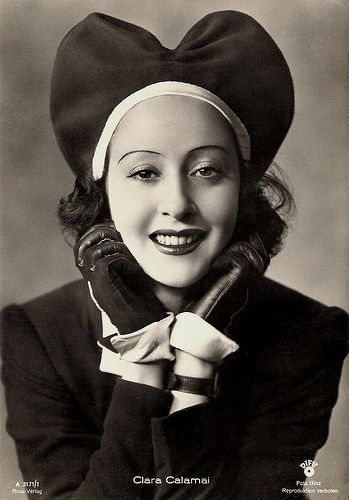
German postcard by Ross Verlag, no. A 3171/1, 1941-1944. Photo: Binz / DIFU.
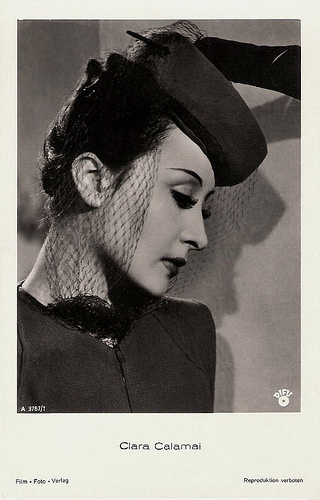
German postcard by Film-Foto-Verlag, no. A 3787/1. Photo: Difu.
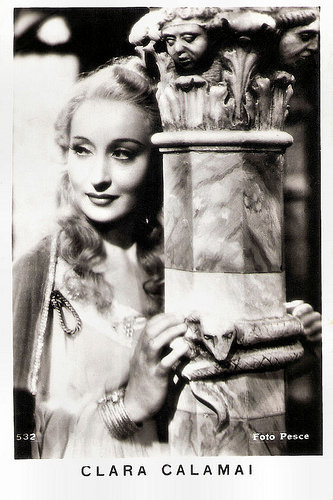
Italian postcard by Armando Terzoli, Roma, no. 532. Photo: Pesce. Publcity still for La Cena delle Beffe/The Jesters' Supper (Alessandro Blasetti, 1941).
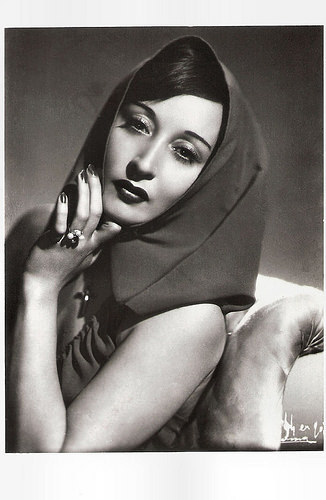
Italian postcard by Ferrania.
Causing A Sensation
Clara Calamai was born in Prato, Tuscany, in 1909. She debuted in the film Pietro Micca (Aldo Vergano, 1938). Soon she had an intense film career.
She played in several period pieces such as La cena delle beffe/The Supper of the Pranks (Alessandro Blasetti, 1941), in which she briefly appeared with bare breasts. The scene caused a sensation. Naked breasts had seldom been seen on an Italian film screen before. A lot of people saw the film several times just for that brief scene. From most of the copies available on the commercial circuit the scene soon disappeared: not because of the wrath of the censors, but because excited projector-operators took their scissors to this bit of cinema memorabilia.
Calamai also appeared in many glamorous comedies and dramas. In 1942 Luchino Visconti prepared his film debut Ossessione/Obsession (1943) with Anna Magnani in the lead. But when the shooting started Magnani was so visibly pregnant that Visconti had to replace her. He stripped Clara Calamai of her usual glamour and turned her into Giovanna, the passionate but poor wife of a fat trattoria owner. Giovanna manages to convince her lover to kill her husband.
The film was based on James M. Cain's book The Postman Always Twice. Ossessione is quite different from the Hollywood version The Postman Always Twice (Tay Garnett, 1946), which stars a very glamorous Lana Turner.
Memorable in Ossessione is the scene in which Giovanna falls asleep amidst an enormous amount of dirty dishes. The real eye catcher of Ossessione is not Giovanna but Gino, the blond hunk she falls in love with, played by Massimo Girotti . At the time, Ossessione had a very short circulation in catholic, fascist Italy because of its 'amorality' and mocking of the clergy. Outside of Italy it was shown only years after the war, because of copyright infringement. Nowadays it is considered by film historians as a classic of the Italian cinema.
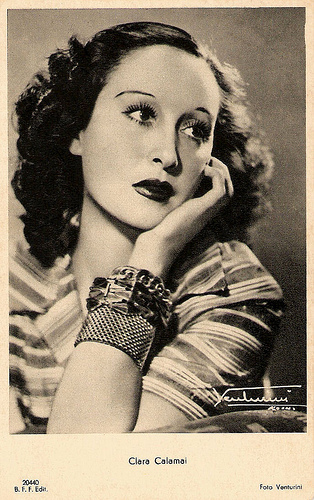
Italian postcard by B.F.F. Edit., no. 20440. Photo: Venturini, Roma.
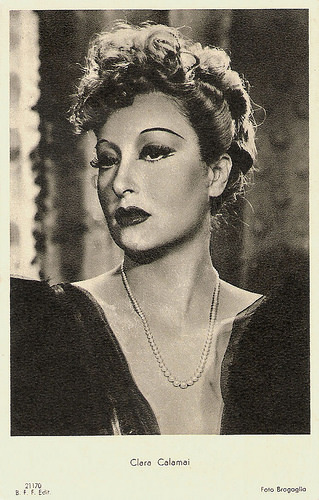
Italian postcard by Casa Editrice Ballerini & Fratini, Firenze, no. 21170. Photo: Bragaglia.
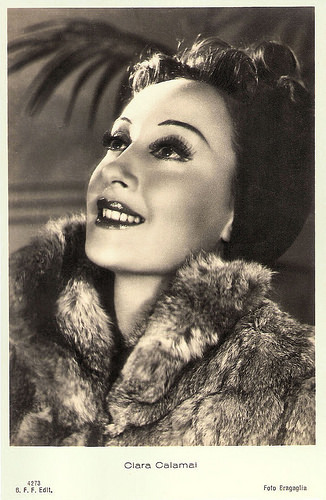
Italian postcard by Casa Editrice Ballerini & Fratini, Firenze, no. 4273. Photo: Bragaglia.
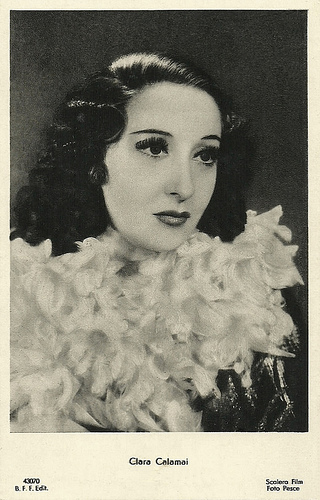
Italian postcard by B.F.F. Edit., no. 43070. Photo Pesce / Scalera Film.
Anna Magnani
In 1946 Clara Calamai landed again a role Anna Magnani was supposed to have played: L'adultera/The Adulteress (Duilio Coletti, 1946), for which she won a Nastro d'argento (the Silver Ribbon, a film award for cinematic performances and production by the association of Italian film critics).
Earlier the opposite had happened. Reportedly Clara Calamai was pregnant when the female lead of Roma, città aperta/Rome Open City (Roberto Rossellini, 1945) was cast. And this time Anna Magnani landed the role, and it would immortalize her.
Calamai worked again with Visconti at Le notti bianche/White Nights (Luchino Visconti, 1957), in which she played a prostitute. Visconti had suggested in Ossessione that before marrying Giovanna had also slept with men for money. In Visconti's episode La strega bruciata viva/The Witch Burned Alive of the episode film Le streghe/The Witches (Luchino Visconti, Mauro Bolognini, Vittorio de Sica, Pier Paolo Pasolini, Franco Rossi, 1966), Calamai played a small part opposite Silvana Mangano . Calamai had a well-publicised but unrequited crush on Visconti.
In the 1970s, after years of retirement, Calamai returned to the screen in Dario Argento's highly successful horror film Profondo Rosso/Deep Red (Dario Argento, 1975). The film and her role as a murderously crazy aging actress got a cult status among cinephiles. She spent the rest of her life in diva-like retirement, shunning the press.
Calamai was married to the aviator-explorer and documentary film maker Leonardo Bonzi. After their divorce she lived with Valerio Andreoli, a captain of aviation. Clara Calamai was almost 90 when she died of a stroke in Rimini in 1998. She had played in almost 50 films.
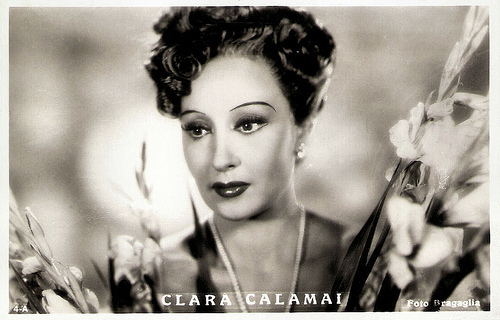
Italian postcard by St. b Angeli, Terni / A. Terzoli, Roma, no. 4.A. Photo: Bragaglia.
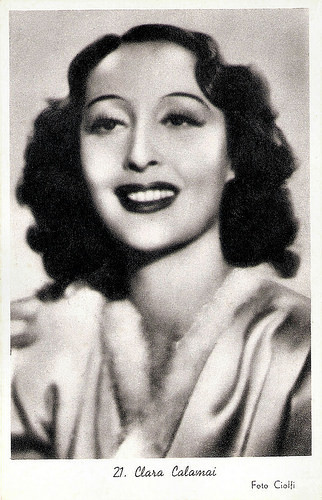
Italian postcard, no. 21. Photo: Ciolfi.
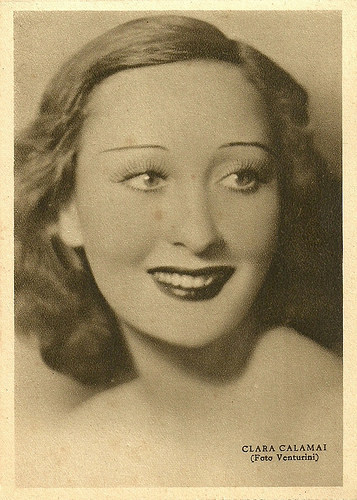
Italian postcard. Photo Venturini. Rizzoli, Milano, 1940.
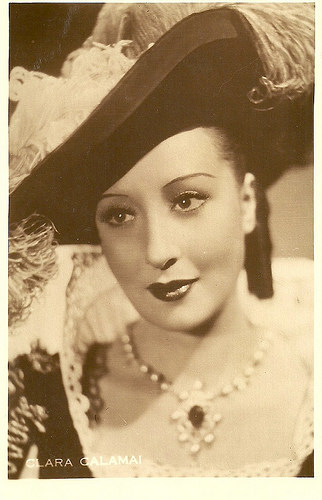
Italian postcard. Editor unknown.
The famous 'nude' scene from La cena delle beffe/The Supper of the Pranks (1941). Source: Giulio Berruti (YouTube).
Scene from Ossessione/Obsession (1943). Source: K de Zwaan (YouTube).
Sources: Anne Henley (The Independent), Sandra Brennan (AllMovie), Wikipedia and .

German postcard by Ross Verlag, no. A 3171/1, 1941-1944. Photo: Binz / DIFU.

German postcard by Film-Foto-Verlag, no. A 3787/1. Photo: Difu.

Italian postcard by Armando Terzoli, Roma, no. 532. Photo: Pesce. Publcity still for La Cena delle Beffe/The Jesters' Supper (Alessandro Blasetti, 1941).

Italian postcard by Ferrania.
Causing A Sensation
Clara Calamai was born in Prato, Tuscany, in 1909. She debuted in the film Pietro Micca (Aldo Vergano, 1938). Soon she had an intense film career.
She played in several period pieces such as La cena delle beffe/The Supper of the Pranks (Alessandro Blasetti, 1941), in which she briefly appeared with bare breasts. The scene caused a sensation. Naked breasts had seldom been seen on an Italian film screen before. A lot of people saw the film several times just for that brief scene. From most of the copies available on the commercial circuit the scene soon disappeared: not because of the wrath of the censors, but because excited projector-operators took their scissors to this bit of cinema memorabilia.
Calamai also appeared in many glamorous comedies and dramas. In 1942 Luchino Visconti prepared his film debut Ossessione/Obsession (1943) with Anna Magnani in the lead. But when the shooting started Magnani was so visibly pregnant that Visconti had to replace her. He stripped Clara Calamai of her usual glamour and turned her into Giovanna, the passionate but poor wife of a fat trattoria owner. Giovanna manages to convince her lover to kill her husband.
The film was based on James M. Cain's book The Postman Always Twice. Ossessione is quite different from the Hollywood version The Postman Always Twice (Tay Garnett, 1946), which stars a very glamorous Lana Turner.
Memorable in Ossessione is the scene in which Giovanna falls asleep amidst an enormous amount of dirty dishes. The real eye catcher of Ossessione is not Giovanna but Gino, the blond hunk she falls in love with, played by Massimo Girotti . At the time, Ossessione had a very short circulation in catholic, fascist Italy because of its 'amorality' and mocking of the clergy. Outside of Italy it was shown only years after the war, because of copyright infringement. Nowadays it is considered by film historians as a classic of the Italian cinema.

Italian postcard by B.F.F. Edit., no. 20440. Photo: Venturini, Roma.

Italian postcard by Casa Editrice Ballerini & Fratini, Firenze, no. 21170. Photo: Bragaglia.

Italian postcard by Casa Editrice Ballerini & Fratini, Firenze, no. 4273. Photo: Bragaglia.

Italian postcard by B.F.F. Edit., no. 43070. Photo Pesce / Scalera Film.
Anna Magnani
In 1946 Clara Calamai landed again a role Anna Magnani was supposed to have played: L'adultera/The Adulteress (Duilio Coletti, 1946), for which she won a Nastro d'argento (the Silver Ribbon, a film award for cinematic performances and production by the association of Italian film critics).
Earlier the opposite had happened. Reportedly Clara Calamai was pregnant when the female lead of Roma, città aperta/Rome Open City (Roberto Rossellini, 1945) was cast. And this time Anna Magnani landed the role, and it would immortalize her.
Calamai worked again with Visconti at Le notti bianche/White Nights (Luchino Visconti, 1957), in which she played a prostitute. Visconti had suggested in Ossessione that before marrying Giovanna had also slept with men for money. In Visconti's episode La strega bruciata viva/The Witch Burned Alive of the episode film Le streghe/The Witches (Luchino Visconti, Mauro Bolognini, Vittorio de Sica, Pier Paolo Pasolini, Franco Rossi, 1966), Calamai played a small part opposite Silvana Mangano . Calamai had a well-publicised but unrequited crush on Visconti.
In the 1970s, after years of retirement, Calamai returned to the screen in Dario Argento's highly successful horror film Profondo Rosso/Deep Red (Dario Argento, 1975). The film and her role as a murderously crazy aging actress got a cult status among cinephiles. She spent the rest of her life in diva-like retirement, shunning the press.
Calamai was married to the aviator-explorer and documentary film maker Leonardo Bonzi. After their divorce she lived with Valerio Andreoli, a captain of aviation. Clara Calamai was almost 90 when she died of a stroke in Rimini in 1998. She had played in almost 50 films.

Italian postcard by St. b Angeli, Terni / A. Terzoli, Roma, no. 4.A. Photo: Bragaglia.

Italian postcard, no. 21. Photo: Ciolfi.

Italian postcard. Photo Venturini. Rizzoli, Milano, 1940.

Italian postcard. Editor unknown.
The famous 'nude' scene from La cena delle beffe/The Supper of the Pranks (1941). Source: Giulio Berruti (YouTube).
Scene from Ossessione/Obsession (1943). Source: K de Zwaan (YouTube).
Sources: Anne Henley (The Independent), Sandra Brennan (AllMovie), Wikipedia and .
Published on March 21, 2016 23:00
March 20, 2016
Paula Wessely
Paula Wessely (1907-2000) reigned as Austria’s most distinguished and beloved stage and screen actress almost from her debut at the Vienna Volkstheater in 1924 until her retirement in 1987. She was also criticised for her appearance in the Nazi-propaganda film Heimkehr/Homecoming (1941).
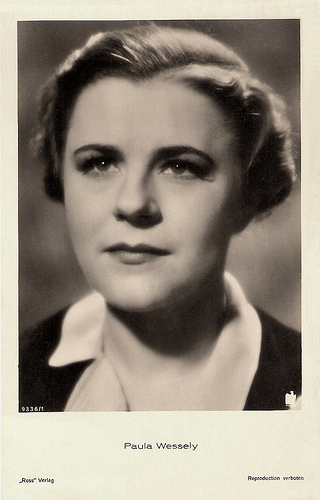
German postcard by Ross Verlag, no. 9336/1, 1935-1936.
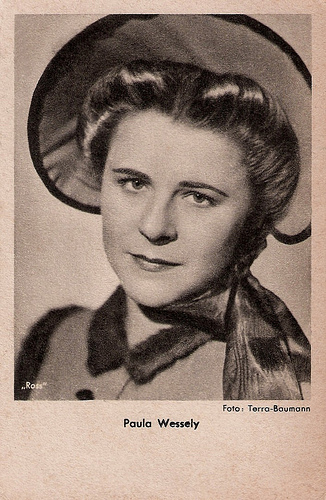
German postcard by Ross. Photo: Terra / Baumann.
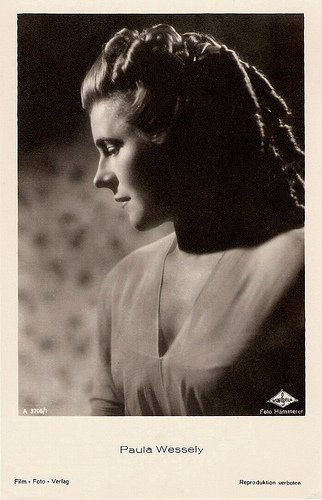
German postcard by Film-Foto-Verlag, no. A 3706/1, 1941-1944. Photo: Hämmerer / Wien Film.
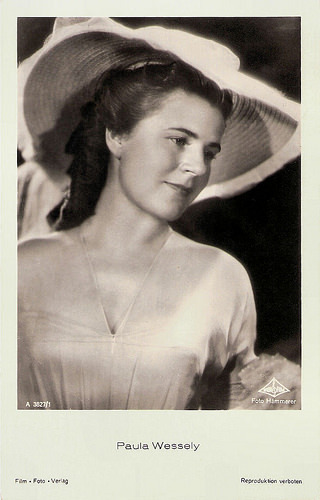
German postcard by Film-Foto-Verlag, no. A 3827/1, 1941-1944. Photo: Hämmerer / Wien Film.
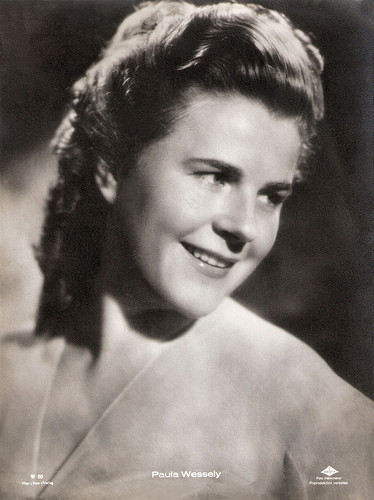
German postcard by Film-Foto-Verlag, no. W 80. Photo: Hämmerer / Wien Film.
Not the typical film beauty
Paula Anna Maria Wessely was born in Vienna, Austria-Hungary, now Austria, in 1907. She was the second daughter of butcher and theatre enthusiast Carl Wessely and his wife Anna Wessely-Orth. Carl Wessely’s elder sister, Josephine Wessely was an admired and successful actress of the Burgtheater in Vienna, when she died in 1887, only 27 years old.
Paula studied acting at the famous Max-Reinhardt-Seminar. In 1924, she made her debut at the Wiener Volkstheater, but she first came to attention in 1929 at the popular Theater in der Josefstadt under the direction of Max Reinhardt.
Three years later followed her breakthrough as Rose Bernd in the play by Gerhart Hauptmann. Other great stage roles were the title role in the operetta Sissy (1932) by Fritz Kreisler, Christine in the first presentation of Liebelei (Flirtation, 1933), and Gretchen in Goethe's Faust (1933) at the Salzburger Festspiele (The Salzburg Festival).
Although she was not the typical film beauty, she starred in many films. Her first major screen role was Leopoldine Dur in Maskerade/Masquerade in Vienna (Willi Forst, 1934) at the side of Adolf Wohlbrück (aka Anton Walbrook). This social comedy set in turn-of-the-century Vienna with big ball scenes was a huge success and it made Wessely one of the first stars of the Austrian stage who made a successful transition to the cinema.
The next year followed Episode (Walter Reisch, 1935), for which she won the Coppa Volpi award for Best Actress at the Venice Film Festival. Other films like Ernte/Harvest (Géza von Bolváry, 1936) and Spiegel des Lebens/Life's Mirror (Géza von Bolváry, 1938) made her a big film star of the German language cinema. Wessely was known for her sense of pathos and gentle comedy and made several appearances in musical romances.
In 1935, she married actor Attila Hörbiger , with whom she had three daughters: Elisabeth Orth (1936), Christiane Hörbiger (1938) and Maresa Hörbiger (1945). All three daughters would go on to become actresses in the Austrian cinema.
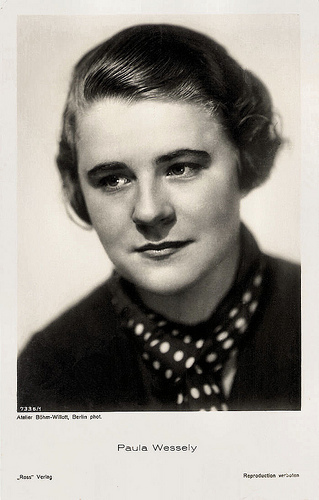
German postcard by Ross Verlag, no. 7336/1, 1932-1933. Photo: Atelier Böhm-Willott, Berlin.
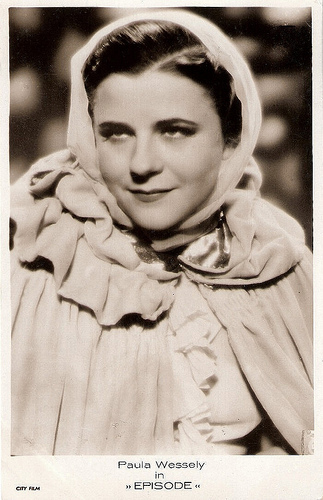
Dutch postcard by M. B. & Z (M. Bonnist & Zonen, Amsterdam). Photo: City Film. Publicity still for Episode (Walter Reisch, 1935). This postcard has at the backside an advertisement for the presentation of Episode at the Harmonie Bioscoop, Tilburg.
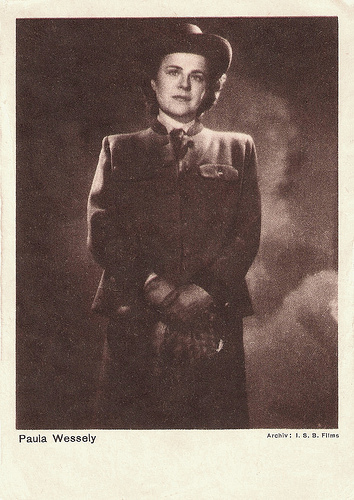
Austrian postcard by Eberle Verlag, Wien (Vienna). Photo: I.S.B. Films.
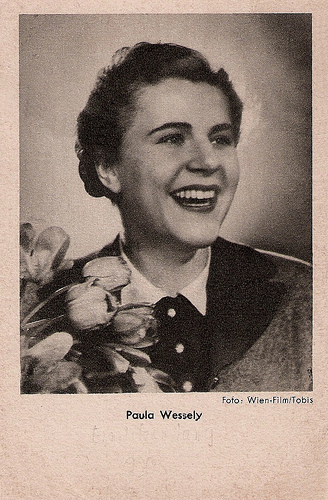
German postcard by Das Programm von Heute, Berlin. Photo: Wien-Film / Tobis.
A Voluntary Nazi Tool
After the Anschluss of Austria in 1936, Paula Wessely became one of the most popular actresses of the Third Reich. She was affectionately called ‘Die Wessely’ by her fans. Her career thrived under Nazi rule when she starred in many projects produced under the aegis of Nazi propaganda minister Joseph Goebbels and his aides.
Till the end of war she took part in films like Ein Leben lang/A Whole Life (Gustav Ucicky, 1940) with Joachim Gottschalk , Späte Liebe/Late Love (Gustav Ucicky, 1943) and Das Herz muss schweigen/The Heart Must Be Silent (Gustav Ucicky, 1944) with Mathias Wiemann.
After the war she was accused of being a voluntary tool of the Nazis. The role she was most resented for was the lead in the anti-Polish propaganda film Heimkehr/Homecoming (Gustav Ucicky, 1941). The Americans gave her a Berufsverbot. She fell into a severe depression and was treated in a hospital. In interviews she later told that she regretted to have appeared in Heimkehr.
In 1947 she was allowed to continue her career on the Vienna stages and her fans had remained faithful to her. She was given a surprising role in the film Der Engel mit der Posaune/The Angel with the Trumpet (Karl Hartl, 1948) as a half-Jewish woman who ultimately fell victim to the Nazis. The book's author, Ernst Lothar, later wrote in his autobiography, Das Wunder des Überlebens , (The Wonder of Survival) that the Americans wanted Wessely for this role as a means of restoring her acting career: they considered the film a vehicle for helping Austrians to overcome the past. The filming promoted reconciliation over the settling of accounts. It worked.
At Film Reference , reviewer Gertraud Steiner Daviau writes: "The splendid performance of Paula Wessely also leads the film in the direction of the usual lighthearted Viennese film; Henriette appears as a positive heroine, which she definitely is not in Lothar's novel. Most viewers therefore accept the film as a generational love story set in Old Vienna rather than as a mirror of the darker side of the Austrian soul and of Austrian history."
During the 1950s Wessely had also success as a producer of her own films with her production company Paula-Wessely-Filmproduktion. To her successes belong Cordula (Gustav Ucicky, 1950), Maria Theresia (Emil E. Reinert, 1951), Der Weg in die Vergangenheit (Karl Hartl, 1954) opposite Willy Fritsch and Willi Forst , and Die unvollkommene Ehe/The Incomplete Marriage (Robert A. Stemmle, 1959) with Johannes Heesters .
In 1957 she appeared in the gay-themed film Anders als du und ich/The Third Sex (Veit Harlan, 1957) as the mother of Christian Wolff . Reportedly, heavy censorship turned the initial fairly positive theme of the film in a negative anti-gay message. The film is now a notorious curiosity in the history of the gay and lesbian cinema.
Her last film was Jedermann/Everyman (Gottfried Reinhardt, 1961) with Walter Reyer. Besides her film work, Wessely had a glittering career at the Vienna Burgtheater, where she worked since 1953 until her retirement. She was seen as the incarnation of the melancholy and the charm of an entire nation. During her career she won many prizes, including the Bambi award in 1962 and the Filmband in Gold in 1984 for her long and outstanding contributions to the German cinema.
Attila Hörbiger died in 1987, aged 91, of a stroke. Thereafter, the 'doyenne of the Vienna Burgtheater' retired at the age of 80. In her last years she lived a very secluded life in her hometown Vienna and suffered from a major depression, caused by the death of her beloved husband. They were married for 52 years. Paula Wessely died in 2000 at the venerable age of 93 in a hospital in Vienna.
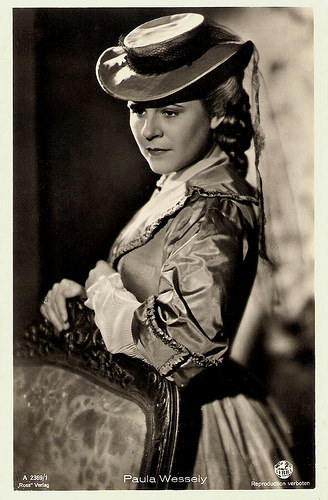
German postcard by Ross Verlag, no. A 2369/1, 1939-1940. Photo: Terra.
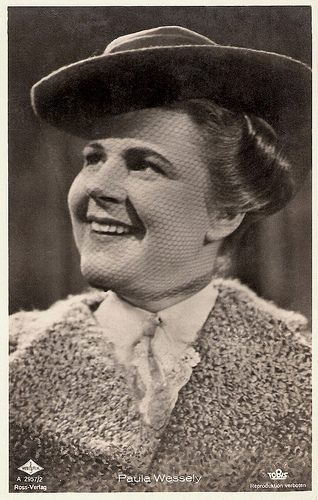
German postcard by Ross Verlag, no. A 2957/2, 1939-1940. Photo: Wien-Film / Tobis.
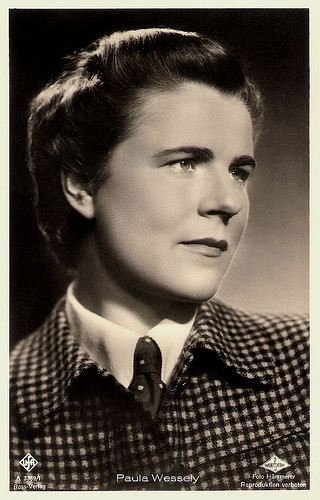
German postcard by Film-Foto-Verlag, no. A 3369/1, 1941-1944. Photo: Hammerer / Wien Film / Ufa.
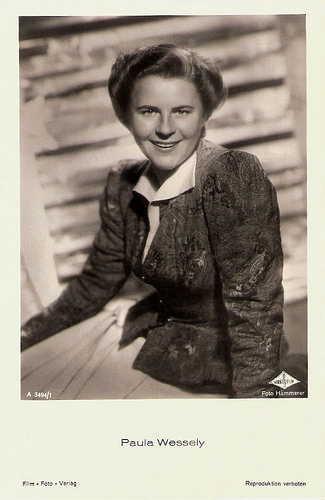
German postcard by Film-Foto-Verlag, no. A 3494/1, 1941-1944. Photo: Hämmerer / Wien Film.
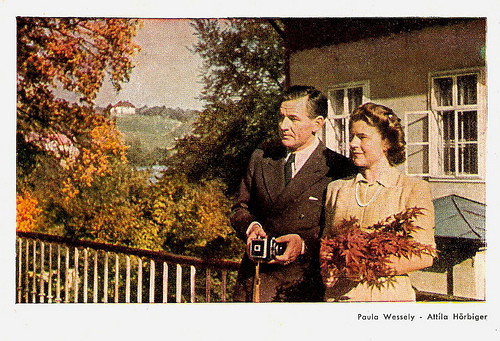
With Atila Hörbiger . German postcard by Verlag und Druckerei Erwin Preuss, Dresden-Freital, Serie 1, no. 9. Photo: Charlott Serda. This is one of the first full colour star postcards.
Sources: Los Angeles Times, Thomas Staedeli (Cyranos), Gertraud Steiner Daviau (Film Reference), Encyclopedia Brittanica, Wikipedia and .

German postcard by Ross Verlag, no. 9336/1, 1935-1936.

German postcard by Ross. Photo: Terra / Baumann.

German postcard by Film-Foto-Verlag, no. A 3706/1, 1941-1944. Photo: Hämmerer / Wien Film.

German postcard by Film-Foto-Verlag, no. A 3827/1, 1941-1944. Photo: Hämmerer / Wien Film.

German postcard by Film-Foto-Verlag, no. W 80. Photo: Hämmerer / Wien Film.
Not the typical film beauty
Paula Anna Maria Wessely was born in Vienna, Austria-Hungary, now Austria, in 1907. She was the second daughter of butcher and theatre enthusiast Carl Wessely and his wife Anna Wessely-Orth. Carl Wessely’s elder sister, Josephine Wessely was an admired and successful actress of the Burgtheater in Vienna, when she died in 1887, only 27 years old.
Paula studied acting at the famous Max-Reinhardt-Seminar. In 1924, she made her debut at the Wiener Volkstheater, but she first came to attention in 1929 at the popular Theater in der Josefstadt under the direction of Max Reinhardt.
Three years later followed her breakthrough as Rose Bernd in the play by Gerhart Hauptmann. Other great stage roles were the title role in the operetta Sissy (1932) by Fritz Kreisler, Christine in the first presentation of Liebelei (Flirtation, 1933), and Gretchen in Goethe's Faust (1933) at the Salzburger Festspiele (The Salzburg Festival).
Although she was not the typical film beauty, she starred in many films. Her first major screen role was Leopoldine Dur in Maskerade/Masquerade in Vienna (Willi Forst, 1934) at the side of Adolf Wohlbrück (aka Anton Walbrook). This social comedy set in turn-of-the-century Vienna with big ball scenes was a huge success and it made Wessely one of the first stars of the Austrian stage who made a successful transition to the cinema.
The next year followed Episode (Walter Reisch, 1935), for which she won the Coppa Volpi award for Best Actress at the Venice Film Festival. Other films like Ernte/Harvest (Géza von Bolváry, 1936) and Spiegel des Lebens/Life's Mirror (Géza von Bolváry, 1938) made her a big film star of the German language cinema. Wessely was known for her sense of pathos and gentle comedy and made several appearances in musical romances.
In 1935, she married actor Attila Hörbiger , with whom she had three daughters: Elisabeth Orth (1936), Christiane Hörbiger (1938) and Maresa Hörbiger (1945). All three daughters would go on to become actresses in the Austrian cinema.

German postcard by Ross Verlag, no. 7336/1, 1932-1933. Photo: Atelier Böhm-Willott, Berlin.

Dutch postcard by M. B. & Z (M. Bonnist & Zonen, Amsterdam). Photo: City Film. Publicity still for Episode (Walter Reisch, 1935). This postcard has at the backside an advertisement for the presentation of Episode at the Harmonie Bioscoop, Tilburg.

Austrian postcard by Eberle Verlag, Wien (Vienna). Photo: I.S.B. Films.

German postcard by Das Programm von Heute, Berlin. Photo: Wien-Film / Tobis.
A Voluntary Nazi Tool
After the Anschluss of Austria in 1936, Paula Wessely became one of the most popular actresses of the Third Reich. She was affectionately called ‘Die Wessely’ by her fans. Her career thrived under Nazi rule when she starred in many projects produced under the aegis of Nazi propaganda minister Joseph Goebbels and his aides.
Till the end of war she took part in films like Ein Leben lang/A Whole Life (Gustav Ucicky, 1940) with Joachim Gottschalk , Späte Liebe/Late Love (Gustav Ucicky, 1943) and Das Herz muss schweigen/The Heart Must Be Silent (Gustav Ucicky, 1944) with Mathias Wiemann.
After the war she was accused of being a voluntary tool of the Nazis. The role she was most resented for was the lead in the anti-Polish propaganda film Heimkehr/Homecoming (Gustav Ucicky, 1941). The Americans gave her a Berufsverbot. She fell into a severe depression and was treated in a hospital. In interviews she later told that she regretted to have appeared in Heimkehr.
In 1947 she was allowed to continue her career on the Vienna stages and her fans had remained faithful to her. She was given a surprising role in the film Der Engel mit der Posaune/The Angel with the Trumpet (Karl Hartl, 1948) as a half-Jewish woman who ultimately fell victim to the Nazis. The book's author, Ernst Lothar, later wrote in his autobiography, Das Wunder des Überlebens , (The Wonder of Survival) that the Americans wanted Wessely for this role as a means of restoring her acting career: they considered the film a vehicle for helping Austrians to overcome the past. The filming promoted reconciliation over the settling of accounts. It worked.
At Film Reference , reviewer Gertraud Steiner Daviau writes: "The splendid performance of Paula Wessely also leads the film in the direction of the usual lighthearted Viennese film; Henriette appears as a positive heroine, which she definitely is not in Lothar's novel. Most viewers therefore accept the film as a generational love story set in Old Vienna rather than as a mirror of the darker side of the Austrian soul and of Austrian history."
During the 1950s Wessely had also success as a producer of her own films with her production company Paula-Wessely-Filmproduktion. To her successes belong Cordula (Gustav Ucicky, 1950), Maria Theresia (Emil E. Reinert, 1951), Der Weg in die Vergangenheit (Karl Hartl, 1954) opposite Willy Fritsch and Willi Forst , and Die unvollkommene Ehe/The Incomplete Marriage (Robert A. Stemmle, 1959) with Johannes Heesters .
In 1957 she appeared in the gay-themed film Anders als du und ich/The Third Sex (Veit Harlan, 1957) as the mother of Christian Wolff . Reportedly, heavy censorship turned the initial fairly positive theme of the film in a negative anti-gay message. The film is now a notorious curiosity in the history of the gay and lesbian cinema.
Her last film was Jedermann/Everyman (Gottfried Reinhardt, 1961) with Walter Reyer. Besides her film work, Wessely had a glittering career at the Vienna Burgtheater, where she worked since 1953 until her retirement. She was seen as the incarnation of the melancholy and the charm of an entire nation. During her career she won many prizes, including the Bambi award in 1962 and the Filmband in Gold in 1984 for her long and outstanding contributions to the German cinema.
Attila Hörbiger died in 1987, aged 91, of a stroke. Thereafter, the 'doyenne of the Vienna Burgtheater' retired at the age of 80. In her last years she lived a very secluded life in her hometown Vienna and suffered from a major depression, caused by the death of her beloved husband. They were married for 52 years. Paula Wessely died in 2000 at the venerable age of 93 in a hospital in Vienna.

German postcard by Ross Verlag, no. A 2369/1, 1939-1940. Photo: Terra.

German postcard by Ross Verlag, no. A 2957/2, 1939-1940. Photo: Wien-Film / Tobis.

German postcard by Film-Foto-Verlag, no. A 3369/1, 1941-1944. Photo: Hammerer / Wien Film / Ufa.

German postcard by Film-Foto-Verlag, no. A 3494/1, 1941-1944. Photo: Hämmerer / Wien Film.

With Atila Hörbiger . German postcard by Verlag und Druckerei Erwin Preuss, Dresden-Freital, Serie 1, no. 9. Photo: Charlott Serda. This is one of the first full colour star postcards.
Sources: Los Angeles Times, Thomas Staedeli (Cyranos), Gertraud Steiner Daviau (Film Reference), Encyclopedia Brittanica, Wikipedia and .
Published on March 20, 2016 23:00
March 19, 2016
Oleg Tabakov
Oleg Tabakov (1935) is a renown Soviet and Russian actor and the artistic director of the Moscow Art Theatre. Tabakov's film career was equally impressive with roles as Count Nikita Rostov in Voyna i mir I/War and Peace (1966-1967) by Sergei Bondarchuk, and as the title figure in Oblomow (1981) by Nikita Mikhalkov.
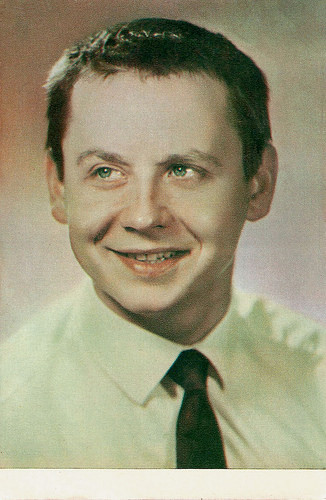
Russian postcard by Izdanije Byuro Propogandy Sovietskogo Kinoiskusstva, no. A 11212. Photo: B. Vilenkina, G. Ter-Ovanesova.
War and Peace
Oleg Pavlovich Tabakov (Russian: Олег Павлович Табаков) was born in Saratov, USSR (now Saratovskaya oblast, Russia) in 1935. His father, Pavel Kongratevich, and his mother, Maria Andreevna Berezovskaya, were medical doctors in Saratov. His parents separated during the Second World War, and young Tabakov was brought up by his single mother and grandmother.
Oleg attended the all-boys school in Saratov, and was active in the drama class. From 1950-1953 he studied acting at the Saratov House of Pioneers under the legendary acting coach Natalia Iosifivna Sukhostav. In 1953, Tabakov moved to Moscow and studied at the Moscow Art Theatre School.
In 1957 he graduated from the school, and became one of the founding fathers of the Sovremennik Theatre. There he played leading roles in such productions as Goly Korol (Naked King), Tri Zhelaniya (Three Wishes), Obyknovennaya istoriya (Ordinary story) and other contemporary Russian plays. From 1970 till 1976 Tabakov was General Manager of Sovremennik, he promoted Galina Volchek to Principal Director of the company.
He administrated the Sovremennik until 1982, when he moved to the Moscow Art Theatre, where he played Molière and Salieri for over 20 years. In 1986, Tabakov persuaded his students to form the Tabakov Studio attached to the Moscow Art Theatre. Several notable Russian actors including Yevgeny Mironov, Sergey Bezrukov, Vladimir Mashkov, Andrey Smolyakov and Alexandre Marine studied at the studio.
Tabakov also spread his theatre's ideals abroad. His teaching credentials include workshops and productions at the Paris Conservatoire, the British American Drama Academy, Akademie Der Künst in Hamburg, the Max Reinhardt Seminar in Vienna, Carnegie Mellon, The Juilliard School, New York University, Florida State University, The University of Delaware, and Harvard University.
For his stage work he won several medals an honours. Tabakov's film career paralleled his theatrical career. He made his film debut as Sasha in the drama Sasha vstupayet v zhizn/Sasha Enters Life (Mikhail Shvejtser, 1957). Soon followed roles in the crime drama Ispytatelnyy Srok/The Probation (Vladimir Gerasimov, 1960) and the war drama Chistoe nebo/Clear Skies (Grigori Chukhrai, 1961) with Yevgeni Urbansky . He appeared in the role of Nikolai Rostov in Sergei Bondarchuk 's Voyna i mir I/War and Peace (1966–1967),
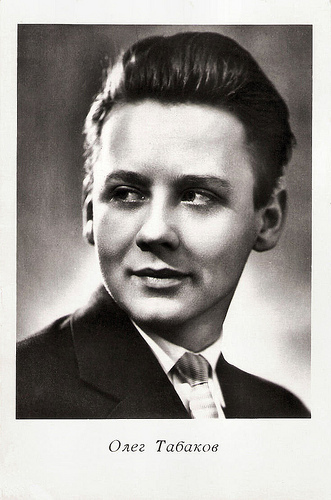
Russian postcard by Izdanije Byuro Propogandy Sovietskogo Kinoiskusstva, no. 3744, 1963.
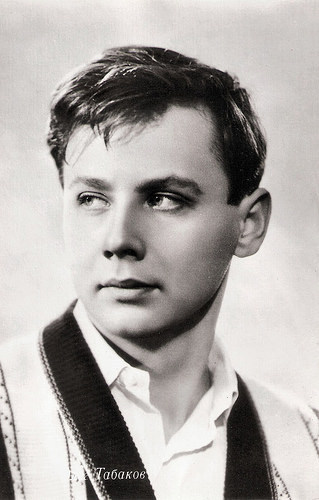
Russian postcard by Izdanije Byuro Propogandy Sovietskogo Kinoiskusstva, no. A 07154.
Moscow Does Not Believe In Tears
Oleg Tabakov played the lead role in the comedy-drama Gori, gori, moya zvezda/Shine, Shine, My Star (Aleksandr Mitta, 1970). Then followed parts in popular TV series as Semnadtsat mgnoveniy vesny/Seventeen Instants of Spring (Tatyana Lioznova, 1973), starring Vyacheslav Tikhonov, and D'Artanyan i tri mushketyora/D'Artagnan and Three Musketeers (Georgi Yungvald-Khilkevich, 1978).
An international success was Neokonchennaya pyesa dlya mekhanicheskogo pianino/An Unfinished Piece for a Piano Player (Nikita Mikhalkov, 1977). His later films include the Academy Award-winning Moskva slezam ne verit/Moscow Does Not Believe In Tears (Vladimir Menshov, 1980), the international art house hits Oblomov (Nikita Mikhalkov, 1981) and Oci ciornie/Dark Eyes (Nikita Mikhalkov, 1986) starring Marcello Mastroianni .
Tabakov also played in the mock slapstick Western Chelovek s bulvara Kaputsinov/A Man from the Boulevard des Capuchines (Alla Surikova, 1987) about Mr Jonny First (Andei Mironov), who arrives in the Wild West to present the art of the Cinematograph. Over 40 million people in the USSR paid to see the feature. Tabakov has lend his distinctive, purr-like voice to a number of animated characters, including the talking cat Matroskin in the animation film Kanikuly v Prostokvashino/Three from Prostokvashino (Vladimir Popov, 1980) and its sequels. After the Matroskin role he dubbed the character of Garfield into Russian in the feature film Garfield (Peter Hewitt, 2004).
During the 1990s, Oleg Tabakov was a strong supporter of democratic reforms and freedom in the new Russia. He made public speeches and was involved in many public events facilitating the cultural transformation of arts and theatres in Russia. He also continued to appear in films, such as in The Inner Circle (Andrey Konchalovskiy, 1991), about Stalin's private film projectionist from (Tom Hulce), the TV movie Stalin (Ivan Passer, 1992) with Robert Duvall, and Taking Sides (István Szabó, 2001) with Harvey Keitel.
Oleg Tabakov was designated People's Actor of the USSR and Russia in the 1980s, and was decorated with the Order of Merit of Fatherland II degree, by the Russian president, Vladimir Putin, in 2005. During the 2012 Russian presidential election Tabakov was registered as a ‘Trusted Representative’ of Putin. In March 2014, he signed a letter in support of the position of Putin on Russia's military intervention in Ukraine.
Tabakov was married twice. His first wife was actress Lyudmila Krylova (1960–1994) with whom he has two children. Their son Anton Tabakov is an actor and also a successful night-club owner in Moscow. Since 1994 Oleg Tabakov is married to actress Marina Zudina. The couple has two children, son Pavel (1996), and daughter Maria (2006). The Tabakovs are living in Moscow, Russia. His most recent film is the comedy Kukhnya v Parizhe/A Kitchen in Paris (Dmitriy Dyachenko, 2014) with Vincent Perez.
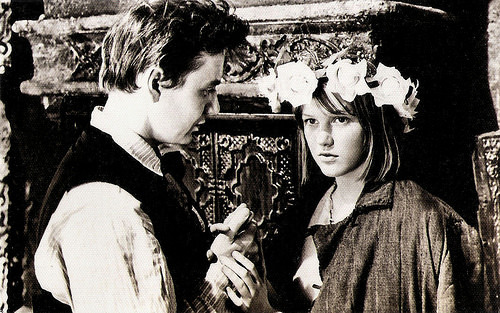
Russian postcard by Izdanije Byuro Propogandy Sovietskogo Kinoiskusstva, no. 1984. Publicity still for Gori, Gori, Moya Zvezda (Aleksandr Mitta, 1970) with Elena Proklova.
Sources: (IMDb), AllMovie, Wikipedia, and .

Russian postcard by Izdanije Byuro Propogandy Sovietskogo Kinoiskusstva, no. A 11212. Photo: B. Vilenkina, G. Ter-Ovanesova.
War and Peace
Oleg Pavlovich Tabakov (Russian: Олег Павлович Табаков) was born in Saratov, USSR (now Saratovskaya oblast, Russia) in 1935. His father, Pavel Kongratevich, and his mother, Maria Andreevna Berezovskaya, were medical doctors in Saratov. His parents separated during the Second World War, and young Tabakov was brought up by his single mother and grandmother.
Oleg attended the all-boys school in Saratov, and was active in the drama class. From 1950-1953 he studied acting at the Saratov House of Pioneers under the legendary acting coach Natalia Iosifivna Sukhostav. In 1953, Tabakov moved to Moscow and studied at the Moscow Art Theatre School.
In 1957 he graduated from the school, and became one of the founding fathers of the Sovremennik Theatre. There he played leading roles in such productions as Goly Korol (Naked King), Tri Zhelaniya (Three Wishes), Obyknovennaya istoriya (Ordinary story) and other contemporary Russian plays. From 1970 till 1976 Tabakov was General Manager of Sovremennik, he promoted Galina Volchek to Principal Director of the company.
He administrated the Sovremennik until 1982, when he moved to the Moscow Art Theatre, where he played Molière and Salieri for over 20 years. In 1986, Tabakov persuaded his students to form the Tabakov Studio attached to the Moscow Art Theatre. Several notable Russian actors including Yevgeny Mironov, Sergey Bezrukov, Vladimir Mashkov, Andrey Smolyakov and Alexandre Marine studied at the studio.
Tabakov also spread his theatre's ideals abroad. His teaching credentials include workshops and productions at the Paris Conservatoire, the British American Drama Academy, Akademie Der Künst in Hamburg, the Max Reinhardt Seminar in Vienna, Carnegie Mellon, The Juilliard School, New York University, Florida State University, The University of Delaware, and Harvard University.
For his stage work he won several medals an honours. Tabakov's film career paralleled his theatrical career. He made his film debut as Sasha in the drama Sasha vstupayet v zhizn/Sasha Enters Life (Mikhail Shvejtser, 1957). Soon followed roles in the crime drama Ispytatelnyy Srok/The Probation (Vladimir Gerasimov, 1960) and the war drama Chistoe nebo/Clear Skies (Grigori Chukhrai, 1961) with Yevgeni Urbansky . He appeared in the role of Nikolai Rostov in Sergei Bondarchuk 's Voyna i mir I/War and Peace (1966–1967),

Russian postcard by Izdanije Byuro Propogandy Sovietskogo Kinoiskusstva, no. 3744, 1963.

Russian postcard by Izdanije Byuro Propogandy Sovietskogo Kinoiskusstva, no. A 07154.
Moscow Does Not Believe In Tears
Oleg Tabakov played the lead role in the comedy-drama Gori, gori, moya zvezda/Shine, Shine, My Star (Aleksandr Mitta, 1970). Then followed parts in popular TV series as Semnadtsat mgnoveniy vesny/Seventeen Instants of Spring (Tatyana Lioznova, 1973), starring Vyacheslav Tikhonov, and D'Artanyan i tri mushketyora/D'Artagnan and Three Musketeers (Georgi Yungvald-Khilkevich, 1978).
An international success was Neokonchennaya pyesa dlya mekhanicheskogo pianino/An Unfinished Piece for a Piano Player (Nikita Mikhalkov, 1977). His later films include the Academy Award-winning Moskva slezam ne verit/Moscow Does Not Believe In Tears (Vladimir Menshov, 1980), the international art house hits Oblomov (Nikita Mikhalkov, 1981) and Oci ciornie/Dark Eyes (Nikita Mikhalkov, 1986) starring Marcello Mastroianni .
Tabakov also played in the mock slapstick Western Chelovek s bulvara Kaputsinov/A Man from the Boulevard des Capuchines (Alla Surikova, 1987) about Mr Jonny First (Andei Mironov), who arrives in the Wild West to present the art of the Cinematograph. Over 40 million people in the USSR paid to see the feature. Tabakov has lend his distinctive, purr-like voice to a number of animated characters, including the talking cat Matroskin in the animation film Kanikuly v Prostokvashino/Three from Prostokvashino (Vladimir Popov, 1980) and its sequels. After the Matroskin role he dubbed the character of Garfield into Russian in the feature film Garfield (Peter Hewitt, 2004).
During the 1990s, Oleg Tabakov was a strong supporter of democratic reforms and freedom in the new Russia. He made public speeches and was involved in many public events facilitating the cultural transformation of arts and theatres in Russia. He also continued to appear in films, such as in The Inner Circle (Andrey Konchalovskiy, 1991), about Stalin's private film projectionist from (Tom Hulce), the TV movie Stalin (Ivan Passer, 1992) with Robert Duvall, and Taking Sides (István Szabó, 2001) with Harvey Keitel.
Oleg Tabakov was designated People's Actor of the USSR and Russia in the 1980s, and was decorated with the Order of Merit of Fatherland II degree, by the Russian president, Vladimir Putin, in 2005. During the 2012 Russian presidential election Tabakov was registered as a ‘Trusted Representative’ of Putin. In March 2014, he signed a letter in support of the position of Putin on Russia's military intervention in Ukraine.
Tabakov was married twice. His first wife was actress Lyudmila Krylova (1960–1994) with whom he has two children. Their son Anton Tabakov is an actor and also a successful night-club owner in Moscow. Since 1994 Oleg Tabakov is married to actress Marina Zudina. The couple has two children, son Pavel (1996), and daughter Maria (2006). The Tabakovs are living in Moscow, Russia. His most recent film is the comedy Kukhnya v Parizhe/A Kitchen in Paris (Dmitriy Dyachenko, 2014) with Vincent Perez.

Russian postcard by Izdanije Byuro Propogandy Sovietskogo Kinoiskusstva, no. 1984. Publicity still for Gori, Gori, Moya Zvezda (Aleksandr Mitta, 1970) with Elena Proklova.
Sources: (IMDb), AllMovie, Wikipedia, and .
Published on March 19, 2016 23:00
March 18, 2016
Valerie Kaprisky
Stunning French actress Valérie Kaprisky (1962) is known for such films as Breathless (1983), La femme publique (1984) and Mouvements du désir (1994).

Romanian postcard by Inter CONTEMPress / Publiturism.
Aphrodite
Valérie Kaprisky was born Valerie Chérès in Neuilly-sur-Seine, Hauts-de-Seine, France in 1962. Kaprisky is her Polish mother's maiden name. She is of Turkish and Argentine descent on her father's side.
During her youth in Cannes she was inspired by the film festival to pursue an acting career. At 17, she she went to Paris and started to attend the Cours Florent. In 1981 she made her film debut with a bit role in Le Jour se lève et les conneries commencent/The sun rises and the bullshit begins (Claude Mulot, 1981).
She was noticed by director Jean-Marie Poiré who offered her a part in his comedy Les Hommes préfèrent les grosses/Men Prefer Fat Girls (1981) starring Josiane Balasko.
Kaprisky had her breakthrough the next year in the French-Swiss erotic film Aphrodite (Robert Fuest, 1982), in which she played the title role opposite Horst Buchholz and Capucine . The film, inspired by the novel Aphrodite: mœurs antiques by Pierre Louÿs, follows a group of people invited on a Mediterranean island for a 3-day fun and frolic fest.
Then she made her American debut, starring alongside Richard Gere in Breathless (Jim McBride, 1983), a remake of the Nouvelle Vague classic A Bout de Souffle (Jean-Luc Godard, 1960). The original film is about an American girl and a French criminal in Paris. The remake is about a French girl and an American criminal in Los Angeles. Breathless received mixed reviews. Many critics questioned the wisdom of casting Kaprisky with her limited acting experience. The film has since gained minor cult status. Quentin Tarantino cited it as one of the ‘coolest movies’.
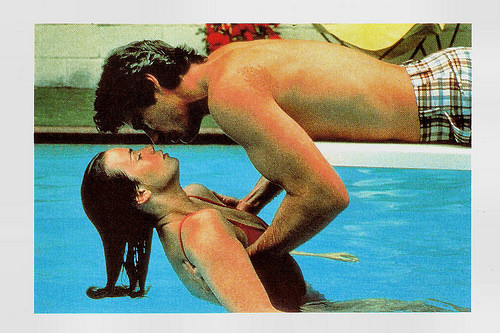
Italian postcard by Ediber-Angelus. Photo: publicity still for Breathless (1983) with Richard Gere.
The Public Woman
Valérie Kaprisky returned to France, where she played the title role in La femme publique/The Public Woman (Andrzej Żuławski, 1984), opposite Lambert Wilson and Francis Huster . She played an inexperienced young actress, who is invited to play a role in a film based on Dostoyevsky's The Possessed.
Yuri German at AllMovie : “Dissatisfied by her performance, the eccentric filmmaker ( Francis Huster ) begins a rigorous course of indoctrination, sexual domination, and acting lessons, leaving the mentally exhausted girl unable to distinguish between the real world and that of the film.” The film was a box office success and for her role Kaprisky was a nominee for the 1985 César Award for Best Actress.
Next she played again a bare-breasted part in the French erotic thriller L'année des méduses/The Year of the Jellyfish (Christopher Frank, 1984) with Bernard Giraudeau and Caroline Cellier. The film was another box office hit in France.
She also appeared as a lawless, exciting gypsy in the comedy Le gitan/The Gypsy (Philippe de Broca, 1986) and opposite André Dussollier in the crime drama in Mon ami le traître/My Friend The Traitor (José Giovanni, 1989).
In Italy she co-starred in the biographical drama Stradivari (Giacomo Battiato, 1988) with Anthony Quinn and Stefania Sandrelli . The film depicts the life and times of Antonio Stradivari, the man who raised the construction of violins to an art form.
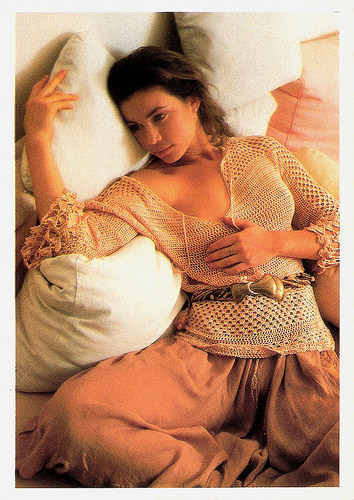
French postcard by Humour à la Carte, Paris, no. ST-154.
By the Pricking of My Thumbs
Valérie Kaprisky played the lead role in Milena/The Lover (Véra Belmont, 1991), the true tale of a Czech journalist and friend of Franz Kafka, who helped the oppressed and was sent to a concentration camp during the war.
Then Kaprisky started to act for television films and her work became less prolific. Her spare feature films in this decade include the Italian film La fine è nota/The End Is Known (Cristina Comencini, 1993) and the Canadian production Mouvements du désir/Desire in Motion (Léa Pool, 1994).
In the new century, she returned more often to the cinema in supporting parts. First she played in Une Place Parmi Les Vivants/A Place Among the Living (Raúl Ruiz, 2003), a philosophical film noir spoof, inspired by the gangster and detective films from the 1950s.
Very popular was the comedy Mon petit doigt m'a dit... /By the Pricking of My Thumbs (Pascal Thomas, 2005) starring Catherine Frot and André Dussollier. The film was based on the novel By the Pricking of My Thumbs by Agatha Christie. She also appeared with Gérard Lanvin in the adventure comedy Envoyés très spéciaux/Special Correspondents (Frédéric Auburtin, 2009).
Recently she starred on French television in the police series Section de recherches (2015) with Xavier Deluc. During the 1980s, Valérie Kaprisky was in a relationship with Anthony Delon . For the last 15 years, she is in a relationship with a composer of scores for documentaries for whose children she is a stepmother.
Trailer Breathless (1983). Source: AgelessTrailers (YouTube).
Trailer La femme publique/The Public Woman (1984). Source: dani77744 (YouTube).
Sources: Yuri German (AllMovie), Films de France, Gala (French), AllMovie, Wikipedia (English and French) and .

Romanian postcard by Inter CONTEMPress / Publiturism.
Aphrodite
Valérie Kaprisky was born Valerie Chérès in Neuilly-sur-Seine, Hauts-de-Seine, France in 1962. Kaprisky is her Polish mother's maiden name. She is of Turkish and Argentine descent on her father's side.
During her youth in Cannes she was inspired by the film festival to pursue an acting career. At 17, she she went to Paris and started to attend the Cours Florent. In 1981 she made her film debut with a bit role in Le Jour se lève et les conneries commencent/The sun rises and the bullshit begins (Claude Mulot, 1981).
She was noticed by director Jean-Marie Poiré who offered her a part in his comedy Les Hommes préfèrent les grosses/Men Prefer Fat Girls (1981) starring Josiane Balasko.
Kaprisky had her breakthrough the next year in the French-Swiss erotic film Aphrodite (Robert Fuest, 1982), in which she played the title role opposite Horst Buchholz and Capucine . The film, inspired by the novel Aphrodite: mœurs antiques by Pierre Louÿs, follows a group of people invited on a Mediterranean island for a 3-day fun and frolic fest.
Then she made her American debut, starring alongside Richard Gere in Breathless (Jim McBride, 1983), a remake of the Nouvelle Vague classic A Bout de Souffle (Jean-Luc Godard, 1960). The original film is about an American girl and a French criminal in Paris. The remake is about a French girl and an American criminal in Los Angeles. Breathless received mixed reviews. Many critics questioned the wisdom of casting Kaprisky with her limited acting experience. The film has since gained minor cult status. Quentin Tarantino cited it as one of the ‘coolest movies’.

Italian postcard by Ediber-Angelus. Photo: publicity still for Breathless (1983) with Richard Gere.
The Public Woman
Valérie Kaprisky returned to France, where she played the title role in La femme publique/The Public Woman (Andrzej Żuławski, 1984), opposite Lambert Wilson and Francis Huster . She played an inexperienced young actress, who is invited to play a role in a film based on Dostoyevsky's The Possessed.
Yuri German at AllMovie : “Dissatisfied by her performance, the eccentric filmmaker ( Francis Huster ) begins a rigorous course of indoctrination, sexual domination, and acting lessons, leaving the mentally exhausted girl unable to distinguish between the real world and that of the film.” The film was a box office success and for her role Kaprisky was a nominee for the 1985 César Award for Best Actress.
Next she played again a bare-breasted part in the French erotic thriller L'année des méduses/The Year of the Jellyfish (Christopher Frank, 1984) with Bernard Giraudeau and Caroline Cellier. The film was another box office hit in France.
She also appeared as a lawless, exciting gypsy in the comedy Le gitan/The Gypsy (Philippe de Broca, 1986) and opposite André Dussollier in the crime drama in Mon ami le traître/My Friend The Traitor (José Giovanni, 1989).
In Italy she co-starred in the biographical drama Stradivari (Giacomo Battiato, 1988) with Anthony Quinn and Stefania Sandrelli . The film depicts the life and times of Antonio Stradivari, the man who raised the construction of violins to an art form.

French postcard by Humour à la Carte, Paris, no. ST-154.
By the Pricking of My Thumbs
Valérie Kaprisky played the lead role in Milena/The Lover (Véra Belmont, 1991), the true tale of a Czech journalist and friend of Franz Kafka, who helped the oppressed and was sent to a concentration camp during the war.
Then Kaprisky started to act for television films and her work became less prolific. Her spare feature films in this decade include the Italian film La fine è nota/The End Is Known (Cristina Comencini, 1993) and the Canadian production Mouvements du désir/Desire in Motion (Léa Pool, 1994).
In the new century, she returned more often to the cinema in supporting parts. First she played in Une Place Parmi Les Vivants/A Place Among the Living (Raúl Ruiz, 2003), a philosophical film noir spoof, inspired by the gangster and detective films from the 1950s.
Very popular was the comedy Mon petit doigt m'a dit... /By the Pricking of My Thumbs (Pascal Thomas, 2005) starring Catherine Frot and André Dussollier. The film was based on the novel By the Pricking of My Thumbs by Agatha Christie. She also appeared with Gérard Lanvin in the adventure comedy Envoyés très spéciaux/Special Correspondents (Frédéric Auburtin, 2009).
Recently she starred on French television in the police series Section de recherches (2015) with Xavier Deluc. During the 1980s, Valérie Kaprisky was in a relationship with Anthony Delon . For the last 15 years, she is in a relationship with a composer of scores for documentaries for whose children she is a stepmother.
Trailer Breathless (1983). Source: AgelessTrailers (YouTube).
Trailer La femme publique/The Public Woman (1984). Source: dani77744 (YouTube).
Sources: Yuri German (AllMovie), Films de France, Gala (French), AllMovie, Wikipedia (English and French) and .
Published on March 18, 2016 23:00
March 17, 2016
EFSP's Dazzling Dozen: Funny Faces
Why are there so many good French caricatures? I love the cartoon series Les Grandes Gueules (The Big Mouths), produced by designers Jean Mulatier, Patrice Ricord and Jean-Claude Morchoisne between 1970 and 1986. The cartoons were first published on the back cover of the magazine Pilote and then combined in the form of albums. But the caricatures by Raoul Cabrol from the 1910s and 1920s are maybe even better. But better decide for yourselves.
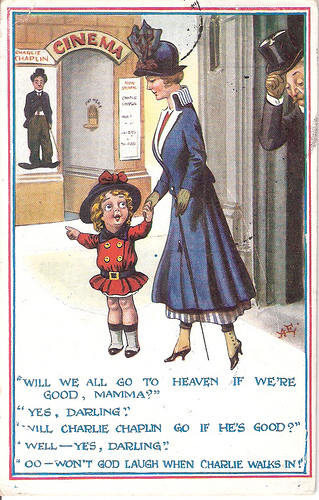
British card in the H. B. Series by "Entire British Production", London, ran 30.7.1917. Cartoon of Charlie Chaplin by AEI.
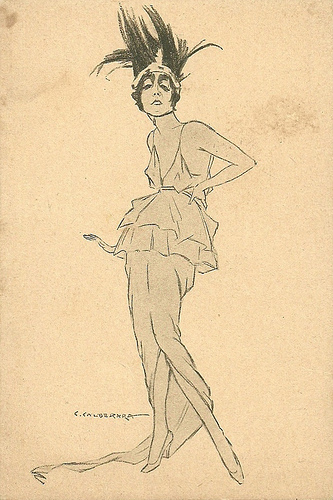
Italian postcard. Caricature of Lyda Borelli by C. Calderara. Looking at the outfit and the headgear, the drawing seems to refer to Borelli's first film Ma l'amor mio non muore/ Love Everlasting (1913).
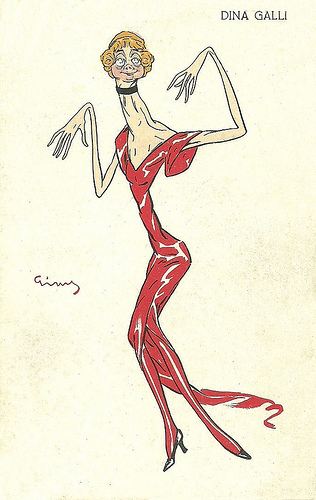
Italian postcard. Caricature of Dina Galli by Girus (Giuseppe Russo). It was exposed in 1914 at the first international exhibition of caricatures and cartoons in Italy.
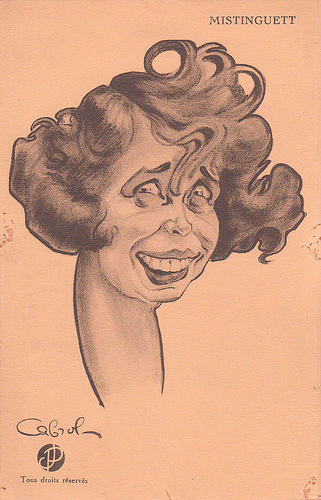
French postcard. Caricature of Mistinguett by Raoul Cabrol. Collection: Marlène Pilaete.
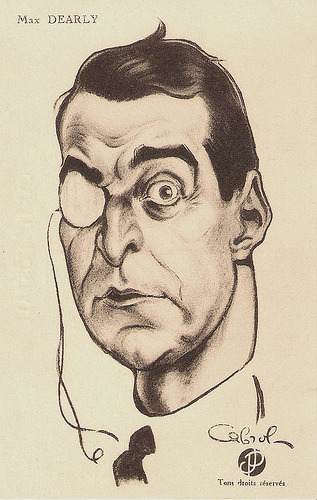
French postcard by Publications J.P., Paris, no. 7. Caricature of Max Dearly by Raoul Cabrol.
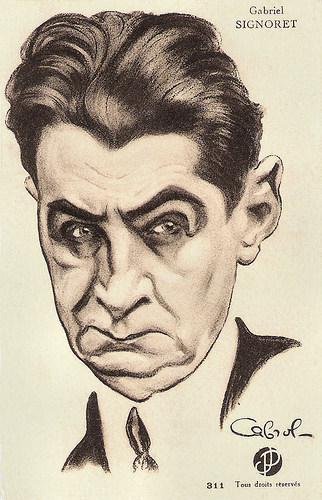
French postcard by Publications J.P., Paris, no. 311. Caricature of Gabriel Signoret by Raoul Cabrol.
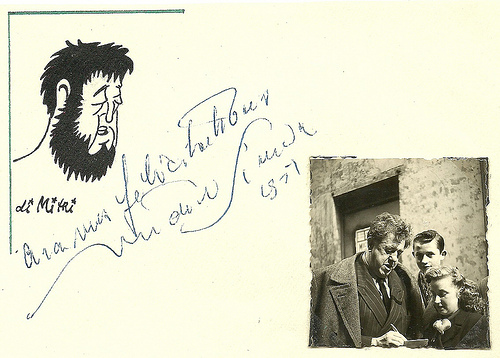
Photo with dedication. Caricature of Michel Simon by di Mitri. Collection: Didier Hanson.
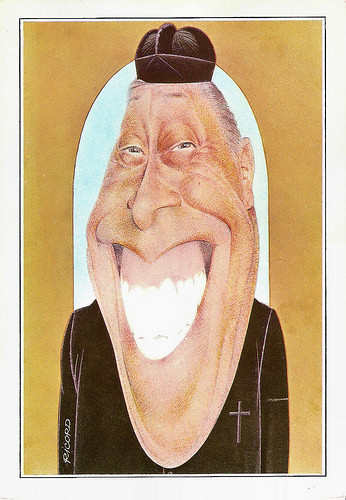
French postcard in the Les Grandes Gueules Series by Dervish International Publications, Paris, no. 105. Caricature of Fernandel as Don Camillo by Patrice Ricord.
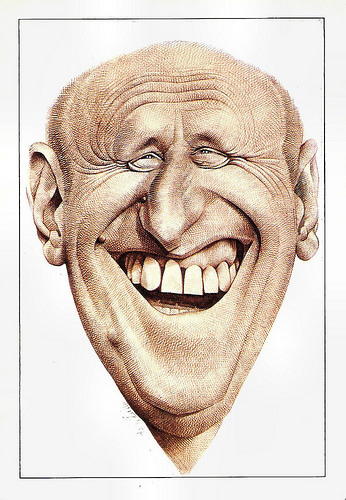
French postcard in the Les Grandes Gueules Series by Dervish International Publications, Paris, no. 106. Caricature of Bourvil by Jean Mulatier.
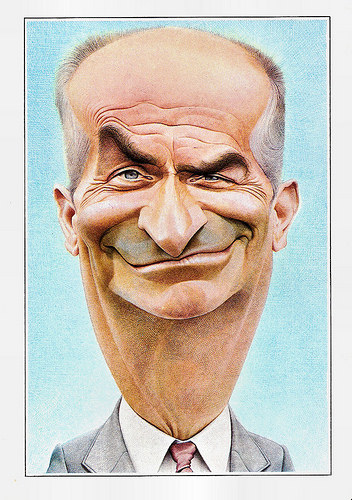
French postcard in the Les Grandes Gueules Series by Dervish International Publications, Paris, no. 102. Caricature of Louis de Funès by Jean Mulatier.
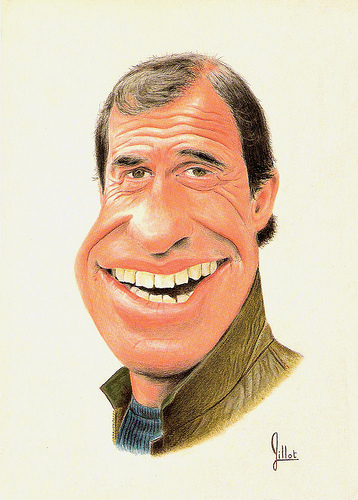
French postcard by Editions et Impressions Combier, Mâcon in the Series Les geants du cinema, no. 1. Caricature of Jean-Paul Belmondo by Jean-Pierre Gillot.
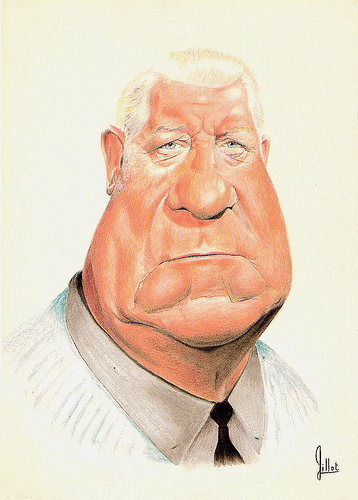
French postcard by Editions et Impressions Combier, Mâcon, no. 3. Caricature of Jean Gabin by Jean-Pierre Gillot.
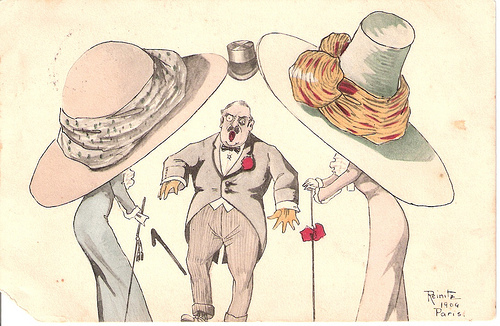
And an extra card. Ladies' hats were getting bigger and bigger in 1904, which would caused many problems in the early cinemas. Caricature by Reinitz, Paris. Austrian postcard sent from Brussels to Embourg par Chenee, Belgium, in 1913.
This is a post for Postcard Friendship Friday, hosted by Beth at the The Best Hearts are Crunchy. You can visit her by clicking on the button below.

Sources: Wikipedia (French and English).

British card in the H. B. Series by "Entire British Production", London, ran 30.7.1917. Cartoon of Charlie Chaplin by AEI.

Italian postcard. Caricature of Lyda Borelli by C. Calderara. Looking at the outfit and the headgear, the drawing seems to refer to Borelli's first film Ma l'amor mio non muore/ Love Everlasting (1913).

Italian postcard. Caricature of Dina Galli by Girus (Giuseppe Russo). It was exposed in 1914 at the first international exhibition of caricatures and cartoons in Italy.

French postcard. Caricature of Mistinguett by Raoul Cabrol. Collection: Marlène Pilaete.

French postcard by Publications J.P., Paris, no. 7. Caricature of Max Dearly by Raoul Cabrol.

French postcard by Publications J.P., Paris, no. 311. Caricature of Gabriel Signoret by Raoul Cabrol.

Photo with dedication. Caricature of Michel Simon by di Mitri. Collection: Didier Hanson.

French postcard in the Les Grandes Gueules Series by Dervish International Publications, Paris, no. 105. Caricature of Fernandel as Don Camillo by Patrice Ricord.

French postcard in the Les Grandes Gueules Series by Dervish International Publications, Paris, no. 106. Caricature of Bourvil by Jean Mulatier.

French postcard in the Les Grandes Gueules Series by Dervish International Publications, Paris, no. 102. Caricature of Louis de Funès by Jean Mulatier.

French postcard by Editions et Impressions Combier, Mâcon in the Series Les geants du cinema, no. 1. Caricature of Jean-Paul Belmondo by Jean-Pierre Gillot.

French postcard by Editions et Impressions Combier, Mâcon, no. 3. Caricature of Jean Gabin by Jean-Pierre Gillot.

And an extra card. Ladies' hats were getting bigger and bigger in 1904, which would caused many problems in the early cinemas. Caricature by Reinitz, Paris. Austrian postcard sent from Brussels to Embourg par Chenee, Belgium, in 1913.
This is a post for Postcard Friendship Friday, hosted by Beth at the The Best Hearts are Crunchy. You can visit her by clicking on the button below.

Sources: Wikipedia (French and English).
Published on March 17, 2016 23:00
March 16, 2016
Leda Gloria
Italian film star Leda Gloria (1912-1997) had a prolific career during the 1930s and 1940s. She was one of the favourite film actresses of the young Federico Fellini, but is also remembered as the wife of mayor Peppone in the Don Camillo films of the 1950s and 1960s. She appeared in 66 films between 1929 and 1965.
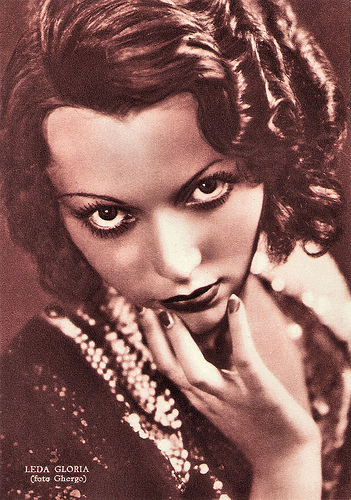
Italian postcard by Rizzoli, 1937. Photo: Ghergo.
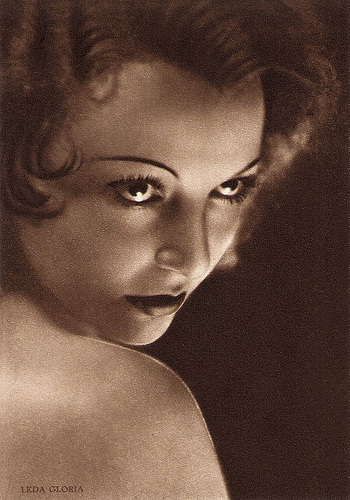
Italian postcard by Rizzoli, Milano, 1940. Photo: Ghergo.
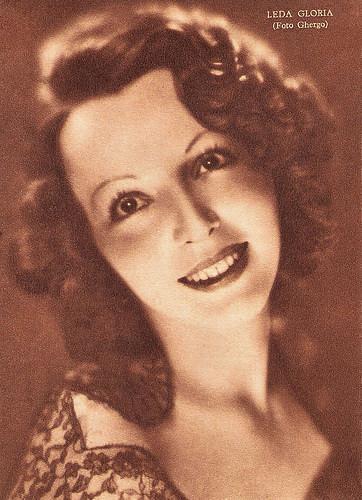
Italian postcard by Rizzoli, Milano, 1942. Photo: Ghergo.
Lively and spontaneous country girls
Leda Gloria, pseudonym of Leda Nicoletti was born in Rome, Italy, in 1912. She started her film career already at a young age, winning a film contest held by an American film company in Italy. She dropped her studies as harpist and acted in various silent Italian and German films.
Gloria’s first film seems to have been the comedy Ragazze non scherzate/Girls do not joke (Alfred Lind, 1929) with Maurizio D’Ancora. Another of her early film roles was next to Lil Dagover in the German sound film Es gibt eine Frau die dich niemals vergisst/There is a woman who never forgets you (Leo Mittler 1930), also with Iván Petrovich .
With the coming of sound cinema she became one of the most active and popular Italian actresses. She first made her mark with two films by Alessandro Blasetti, Terra madre/Mother Earth (1931) and Palio (1932), playing lively and spontaneous country girls. In Terra madre Gloria played country girl Emilia opposite Sandro Salvini, former love interest in the silent diva films. Here he plays a duke who wants to sell his estate and move to the city, but after a fire extinguished with the help of the farmers he decides to stay.
In Palio, jockeys represent various neighbourhoods (contradas) in the Italian city of Siena. The jockeys fight each other and love makes blind. Jockey Zarre (Guido Celano) breaks up his affair with the young Fiora (Gloria) when she is courted by a captain from a rival contrada. When a singer ( Laura Nucci ) in whom he is infatuated, sets up a trap together with his rival in love and horse-riding, Zarre almost fails. Finally he manages to win the Palio, and gains Fiora back as a bonus.
Contrasting the bleak and bloodless 19th century vamps, Gloria showed a healthy beauty and simple but often convincing and solid acting. Examples of this she showed in La tavola dei poveri/The table of the poor (Alessandro Blasetti, 1932) and Il cappello a tre punte/Three Cornered Hat (Mario Camerini, 1934) with Eduardo De Filippo and Peppino De Filippo .
Leda Gloria encountered a big success with her first dramatic character in Montevergine (Carlo Campogalliani, 1939), starring Amedeo Nazzari in a story about a man bound for revenge as he has been wrongly accused of murder and innocently imprisoned.
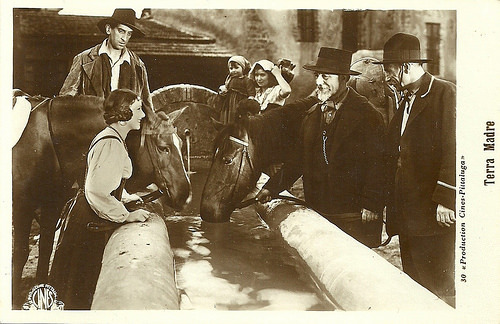
Italian postcard by Produzione Cines-Pittaluga, no. 30. Photo: Leda Gloria had in the rural drama Terra madre (Alessandro Blasetti, 1931).
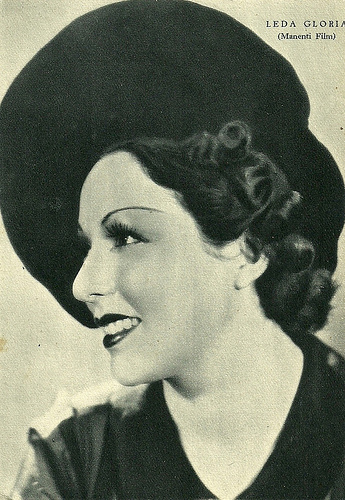
Italian postcard by Rizzoli, 1938. Photo: Manenti Film.
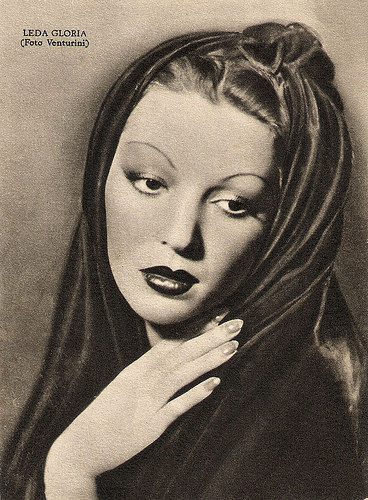
Italian postcard by Rizzoli, Milano, 1941. Sent by mail in 1943. Photo: Venturini.
Fellini's Favourite Actress
Among Leda Gloria’s films from the war years are Antonio Meucci (Enrico Guazzoni, 1940) starring Luigi Pavese as the telephone inventor and Gloria as his wife Ester, Anime in tumulto/Souls in turmoil (Giulio Del Torre, 1942) on a surgeon’s wife who steals a baby when she cannot have one, and Dagli Appennini alle Ande/From the Apennines to the Andes (Flavio Cavalzara, 1943) on a boy (Cesare Barbetti) crossing the ocean and the whole of Argentine in search of his mother (Gloria).
After the war she was involved in variety at the Company of Giulio Donadio. She returned to the cinema with a serious, supporting part in the Neorealist film Il mulino del Po/The Mill on the Po (Carlo Lizzani, 1949), starring Carla Del Poggio and Jacques Sernas and situated in the late 19th century countryside near Ferrara. Future film director Federico Fellini was one of the scriptwriters for this film. He later recalled that she had been one of his favourite actresses.
Subsequently Leda Gloria worked as a supporting actress, often in parts as mothers of the leading characters, but her performances were always moderated and well-delivered. She played Cosetta Greco’s’s mother in Le ragazze di Piazza di Spagna/Girls of the Spanish Steps (Luciano Emmer, 1952) and Raf Mattioli’s mother in the successful comedy Guendalina (Alberto Lattuada, 1957).
Leda Gloria also played Eduardo De Filippo ’s wife in the comedy Napoli milionaria/Side Street Story (Eduardo De Filippo, 1950). It tells the story of ordinary people living on a Naples sidestreet, from 1940 to 1950 under the dominance of the Fascists, the Nazis and then the Allies occupation forces.
Gloria is well remembered as Signora Botazzi, Peppone's wife, in the Don Camillo comedies with Gino Cervi ’s as the communist mayor Peppone and Fernandel as his opponent Don Camillo. The series included Don Camillo/The Little World of Don Camillo (Julien Duvivier, 1952), Il ritorno di Don Camillo/The Return of Don Camillo (Julien Duvivier, 1953), Don Camillo e l’onorevole Peppone/Don Camillo's Last Round (Carmine Gallone, 1955), Don Camillo monsignore… ma non troppo/Don Camillo: Monsignor (Carmine Gallone, 1961) and Il compagno Don Camillo/Don Camillo in Moscow (Luigi Comencini, 1965), Leda Gloria's last film.
After a long illness, Leda Gloria died in Rome, Italy, in 1997. She was 84. Gloria had two twin daughters: Atte Ughetti and Ilia Ughetti. Both appeared with their mother in Redenzione/Redemption (Marcello Albani, 1943). It was their first and only screen appearance.
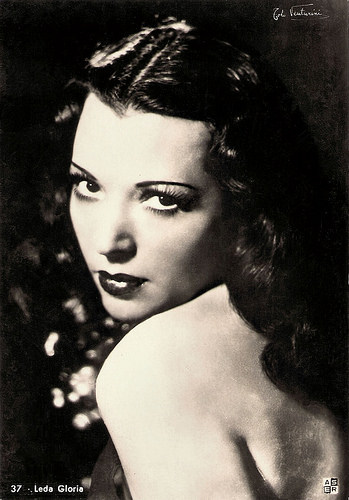
Italian postcard by Aser, no. 37. Photo: Venturini.
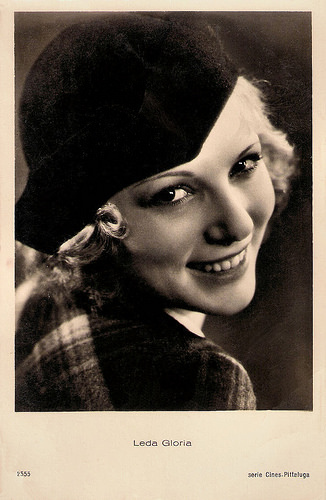
Italian postcard by Casa Editr. Ballerini & Fratini, Firenze, no. 25555. Photo: serie Cines / Pittaluga.
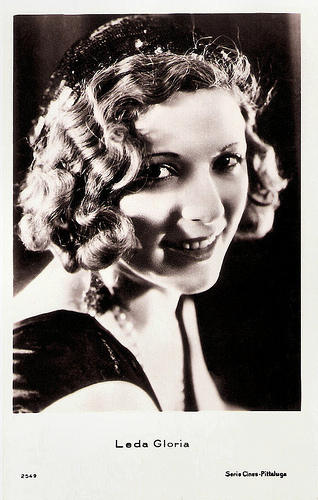
Italian postcard by Casa Editr. Ballerini & Fratini, Firenze, no. 25549. Photo: serie Cines / Pittaluga.
Sources: Adnkronos (Italian), Wikipedia (English and Italian) and .

Italian postcard by Rizzoli, 1937. Photo: Ghergo.

Italian postcard by Rizzoli, Milano, 1940. Photo: Ghergo.

Italian postcard by Rizzoli, Milano, 1942. Photo: Ghergo.
Lively and spontaneous country girls
Leda Gloria, pseudonym of Leda Nicoletti was born in Rome, Italy, in 1912. She started her film career already at a young age, winning a film contest held by an American film company in Italy. She dropped her studies as harpist and acted in various silent Italian and German films.
Gloria’s first film seems to have been the comedy Ragazze non scherzate/Girls do not joke (Alfred Lind, 1929) with Maurizio D’Ancora. Another of her early film roles was next to Lil Dagover in the German sound film Es gibt eine Frau die dich niemals vergisst/There is a woman who never forgets you (Leo Mittler 1930), also with Iván Petrovich .
With the coming of sound cinema she became one of the most active and popular Italian actresses. She first made her mark with two films by Alessandro Blasetti, Terra madre/Mother Earth (1931) and Palio (1932), playing lively and spontaneous country girls. In Terra madre Gloria played country girl Emilia opposite Sandro Salvini, former love interest in the silent diva films. Here he plays a duke who wants to sell his estate and move to the city, but after a fire extinguished with the help of the farmers he decides to stay.
In Palio, jockeys represent various neighbourhoods (contradas) in the Italian city of Siena. The jockeys fight each other and love makes blind. Jockey Zarre (Guido Celano) breaks up his affair with the young Fiora (Gloria) when she is courted by a captain from a rival contrada. When a singer ( Laura Nucci ) in whom he is infatuated, sets up a trap together with his rival in love and horse-riding, Zarre almost fails. Finally he manages to win the Palio, and gains Fiora back as a bonus.
Contrasting the bleak and bloodless 19th century vamps, Gloria showed a healthy beauty and simple but often convincing and solid acting. Examples of this she showed in La tavola dei poveri/The table of the poor (Alessandro Blasetti, 1932) and Il cappello a tre punte/Three Cornered Hat (Mario Camerini, 1934) with Eduardo De Filippo and Peppino De Filippo .
Leda Gloria encountered a big success with her first dramatic character in Montevergine (Carlo Campogalliani, 1939), starring Amedeo Nazzari in a story about a man bound for revenge as he has been wrongly accused of murder and innocently imprisoned.

Italian postcard by Produzione Cines-Pittaluga, no. 30. Photo: Leda Gloria had in the rural drama Terra madre (Alessandro Blasetti, 1931).

Italian postcard by Rizzoli, 1938. Photo: Manenti Film.

Italian postcard by Rizzoli, Milano, 1941. Sent by mail in 1943. Photo: Venturini.
Fellini's Favourite Actress
Among Leda Gloria’s films from the war years are Antonio Meucci (Enrico Guazzoni, 1940) starring Luigi Pavese as the telephone inventor and Gloria as his wife Ester, Anime in tumulto/Souls in turmoil (Giulio Del Torre, 1942) on a surgeon’s wife who steals a baby when she cannot have one, and Dagli Appennini alle Ande/From the Apennines to the Andes (Flavio Cavalzara, 1943) on a boy (Cesare Barbetti) crossing the ocean and the whole of Argentine in search of his mother (Gloria).
After the war she was involved in variety at the Company of Giulio Donadio. She returned to the cinema with a serious, supporting part in the Neorealist film Il mulino del Po/The Mill on the Po (Carlo Lizzani, 1949), starring Carla Del Poggio and Jacques Sernas and situated in the late 19th century countryside near Ferrara. Future film director Federico Fellini was one of the scriptwriters for this film. He later recalled that she had been one of his favourite actresses.
Subsequently Leda Gloria worked as a supporting actress, often in parts as mothers of the leading characters, but her performances were always moderated and well-delivered. She played Cosetta Greco’s’s mother in Le ragazze di Piazza di Spagna/Girls of the Spanish Steps (Luciano Emmer, 1952) and Raf Mattioli’s mother in the successful comedy Guendalina (Alberto Lattuada, 1957).
Leda Gloria also played Eduardo De Filippo ’s wife in the comedy Napoli milionaria/Side Street Story (Eduardo De Filippo, 1950). It tells the story of ordinary people living on a Naples sidestreet, from 1940 to 1950 under the dominance of the Fascists, the Nazis and then the Allies occupation forces.
Gloria is well remembered as Signora Botazzi, Peppone's wife, in the Don Camillo comedies with Gino Cervi ’s as the communist mayor Peppone and Fernandel as his opponent Don Camillo. The series included Don Camillo/The Little World of Don Camillo (Julien Duvivier, 1952), Il ritorno di Don Camillo/The Return of Don Camillo (Julien Duvivier, 1953), Don Camillo e l’onorevole Peppone/Don Camillo's Last Round (Carmine Gallone, 1955), Don Camillo monsignore… ma non troppo/Don Camillo: Monsignor (Carmine Gallone, 1961) and Il compagno Don Camillo/Don Camillo in Moscow (Luigi Comencini, 1965), Leda Gloria's last film.
After a long illness, Leda Gloria died in Rome, Italy, in 1997. She was 84. Gloria had two twin daughters: Atte Ughetti and Ilia Ughetti. Both appeared with their mother in Redenzione/Redemption (Marcello Albani, 1943). It was their first and only screen appearance.

Italian postcard by Aser, no. 37. Photo: Venturini.

Italian postcard by Casa Editr. Ballerini & Fratini, Firenze, no. 25555. Photo: serie Cines / Pittaluga.

Italian postcard by Casa Editr. Ballerini & Fratini, Firenze, no. 25549. Photo: serie Cines / Pittaluga.
Sources: Adnkronos (Italian), Wikipedia (English and Italian) and .
Published on March 16, 2016 23:00
March 15, 2016
Imported from the USA: Shelley Winters
American actress Shelley Winters (1920-2006) appeared in dozens of films, as well as on stage and television. She was a major film presence for six decades, and turned herself from a Blonde Bombshell into a widely-respected actress who won two Oscars, for The Diary of Anne Frank (1959) and A Patch of Blue (1965). Less known, Winters also appeared in several European films, including Alfie 1966 and Roman Polanski's Le Locataire (1976).
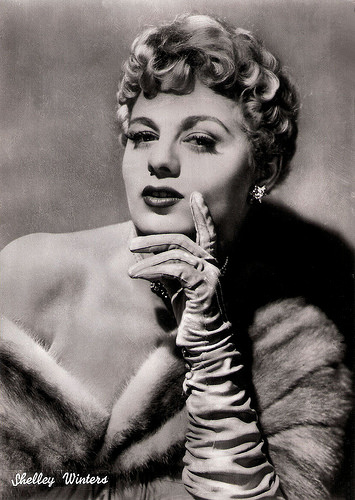
Italian postcard by Bromofoto, Milano, no. 273.
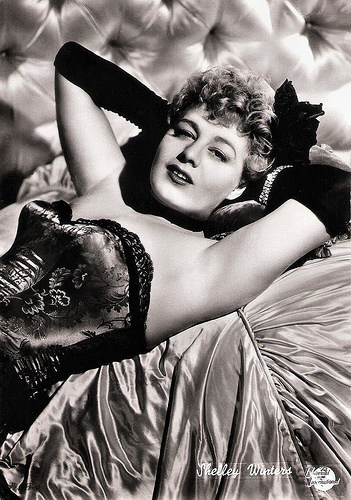
Italian postcard by Bromofoto, Milano, no. 316. Photo: Universal International.
Blonde Bombshell
Shelley Winters was born Shirley Schrift in St. Louis, Missouri, in 1920. She was the daughter of Rose (née Winter), a singer with The Muny, and Jonas Schrift, a designer of men's clothing; her parents were Jewish immigrants. Her family moved to Brooklyn, New York when she was three years old. Winters studied at The New School in New York City, where she appeared in high school plays.
Her first film was What a Woman! (Irving Cummings, 1943) starring Rosalind Russell. Throughout the 1940s, she mostly played bit roles and studied in the Hollywood Studio Club. In the late 1940s, she shared an apartment with another newcomer, Marilyn Monroe.
Winters achieved stardom with her breakout performance as the the party girl waitress who ends as the victim of insane actor Ronald Colman in A Double Life (George Cukor, 1947). She quickly ascended in Hollywood with leading roles in The Great Gatsby (Elliott Nugent, 1949) with Alan Ladd, and Winchester 73 (Anthony Mann, 1950), opposite James Stewart.
Universal Pictures built her up as a Blonde Bombshell but she quickly tired of the role's limitations. She washed off her makeup and played against type to set up Elizabeth Taylor 's beauty in A Place in the Sun (George Stevens, 1951), still a landmark American film. Her performance brought Winters acclaim and a nomination for the Academy Award for Best Actress.
Throughout the 1950s, Winters continued to star in films, including Meet Danny Wilson (Joseph Pevney, 1952) as Frank Sinatra's leading lady, and most notably in Charles Laughton's Night of the Hunter (1955), with Robert Mitchum and Lillian Gish.
In Great Britain she played in the Christopher Isherwood adaptation I Am a Camera (Henry Cornelius, 1955) opposite Julie Harris and Laurence Harvey , and in Italy in Mambo (Robert Rossen, 1954) opposite Silvana Mangano and Winters' second husband Vittorio Gassman .
She also returned to the stage on various occasions during this time, including a Broadway run in A Hatful of Rain (1955–1956), opposite future, third husband Anthony Franciosa. Although she was now in demand as a character actress, Winters continued to study her craft. She attended Charles Laughton 's Shakespeare classes and worked at the Actors Studio, both as student and teacher.
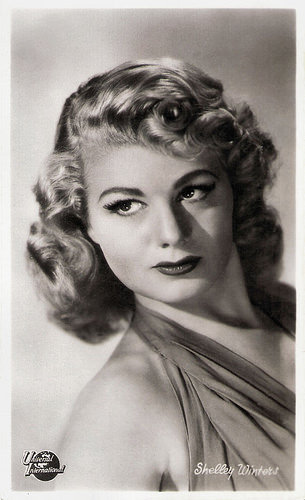
Belgian collectors card by De Beukelaer, Anvers, no. A 7. Photo: Universal International.
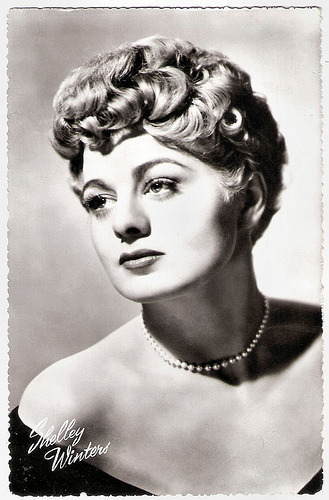
Dutch postcard by DRC, no. F 210. Photo: M.G.M.
Bloody Mama
In 1960, Shelley Winters won an Oscar for Best Supporting Actress for The Diary of Anne Frank (George Stevens, 1959), and six years later, she won another Oscar, in the same category, for A Patch of Blue (Guy Green, 1965). She donated her Oscar for The Diary of Anne Frank to the Anne Frank House in Amsterdam.
Notable roles during the 1960s included her lauded performance as the man-hungry Charlotte Haze in Stanley Kubrick's Lolita (Stanley Kubrick, 1962); starring opposite Michael Caine in Alfie (Lewis Gilbert, 1966), and as the fading, alcoholic former starlet Fay Estabrook in Harper (Jack Smight, 1966).
The following decade she could be seen in The Poseidon Adventure (Ronald Neame, 1972) as the ill-fated Belle Rosen (for which she received her final Oscar nomination), and in Next Stop, Greenwich Village (Paul Mazursky, 1976). Winters also starred in interesting European films like Roman Polanski’s thriller Le Locataire/The Tenant (1976) with Isabelle Adjani , and Mario Monicelli’s drama Un borghese piccolo piccolo/A Very Little Man (1977) with Alberto Sordi .
She returned to the stage during the 1960s and 1970s, most notably in Tennessee Williams' Night of the Iguana. She appeared in such cult films as Wild in the Streets (Barry Shear, 1968), Bloody Mama (Roger Corman, 1970) and Whoever Slew Auntie Roo? (Curtis Harrington, 1971). She also starred in the Broadway musical Minnie's Boys (1970) as Minnie Marx, the mother of Groucho, Harpo, Chico, Zeppo, and Gummo Marx.
During her 50 years as a widely known personality, Winters was rarely out of the news. Her stormy marriages, her romances with famous stars, her forays into politics, and feminist causes kept her name before the public. She delighted in giving provocative interviews and seemed to have an opinion on everything. That led to a second career as a writer. She recalled her conquests in her autobiographies, like Shelley Also Known As Shirley, and wrote of a yearly rendezvous she kept with William Holden, as well as her affairs with Sean Connery , Burt Lancaster , Errol Flynn, Farley Granger and Marlon Brando.
Winters gained significant weight later in life, but lost much of it for (or before) an appearance at the 1998 Academy Awards telecast, which featured a tribute to Oscar winners past and present. In a recurring role in the 1990s, Winters played the title character's grandmother on the ABC sitcom Roseanne.
Her final film roles were supporting ones: she played a restaurant owner and mother of an overweight cook in Heavy (James Mangold, 1995), with Liv Tyler and Debbie Harry, and as an aristocrat in The Portrait of a Lady (Jane Campion, 1996), starring Nicole Kidman and John Malkovich. Her final film was the Italian comedy La bomba (Giulio Base, 1999) with her former husband Vittorio Gassman (whose last film this was too) and his son Alessandro Gassman.
Winters was married four times; her husbands were: Captain Mack Paul Mayer, whom she married on New Year's Day, 1942; they divorced in October 1948. Winters wore his wedding ring up until her death, and kept their relationship very private. In 1952, she married Vittorio Gassman . They divorced in 1954 and had one child, Vittoria (1953), a physician, who practices internal medicine at Norwalk Hospital in Norwalk, Connecticut. She was Winters' only child. Later husbands were Anthony Franciosa (1957-1960) and long-time companion Gerry DeFord, whom she married hours before her death in 2006.
Shelley Winters died at the age of 85 on January 14, 2006, of heart failure at the Rehabilitation Centre of Beverly Hills.
Trailer for Lolita (1962). Source: AgelessTrailers (YouTube).
Trailer for Bloody Mama (1970). Source: Behind The Science Fiction (YouTube).
Sources: (IMDb), Wikipedia, and .

Italian postcard by Bromofoto, Milano, no. 273.

Italian postcard by Bromofoto, Milano, no. 316. Photo: Universal International.
Blonde Bombshell
Shelley Winters was born Shirley Schrift in St. Louis, Missouri, in 1920. She was the daughter of Rose (née Winter), a singer with The Muny, and Jonas Schrift, a designer of men's clothing; her parents were Jewish immigrants. Her family moved to Brooklyn, New York when she was three years old. Winters studied at The New School in New York City, where she appeared in high school plays.
Her first film was What a Woman! (Irving Cummings, 1943) starring Rosalind Russell. Throughout the 1940s, she mostly played bit roles and studied in the Hollywood Studio Club. In the late 1940s, she shared an apartment with another newcomer, Marilyn Monroe.
Winters achieved stardom with her breakout performance as the the party girl waitress who ends as the victim of insane actor Ronald Colman in A Double Life (George Cukor, 1947). She quickly ascended in Hollywood with leading roles in The Great Gatsby (Elliott Nugent, 1949) with Alan Ladd, and Winchester 73 (Anthony Mann, 1950), opposite James Stewart.
Universal Pictures built her up as a Blonde Bombshell but she quickly tired of the role's limitations. She washed off her makeup and played against type to set up Elizabeth Taylor 's beauty in A Place in the Sun (George Stevens, 1951), still a landmark American film. Her performance brought Winters acclaim and a nomination for the Academy Award for Best Actress.
Throughout the 1950s, Winters continued to star in films, including Meet Danny Wilson (Joseph Pevney, 1952) as Frank Sinatra's leading lady, and most notably in Charles Laughton's Night of the Hunter (1955), with Robert Mitchum and Lillian Gish.
In Great Britain she played in the Christopher Isherwood adaptation I Am a Camera (Henry Cornelius, 1955) opposite Julie Harris and Laurence Harvey , and in Italy in Mambo (Robert Rossen, 1954) opposite Silvana Mangano and Winters' second husband Vittorio Gassman .
She also returned to the stage on various occasions during this time, including a Broadway run in A Hatful of Rain (1955–1956), opposite future, third husband Anthony Franciosa. Although she was now in demand as a character actress, Winters continued to study her craft. She attended Charles Laughton 's Shakespeare classes and worked at the Actors Studio, both as student and teacher.

Belgian collectors card by De Beukelaer, Anvers, no. A 7. Photo: Universal International.

Dutch postcard by DRC, no. F 210. Photo: M.G.M.
Bloody Mama
In 1960, Shelley Winters won an Oscar for Best Supporting Actress for The Diary of Anne Frank (George Stevens, 1959), and six years later, she won another Oscar, in the same category, for A Patch of Blue (Guy Green, 1965). She donated her Oscar for The Diary of Anne Frank to the Anne Frank House in Amsterdam.
Notable roles during the 1960s included her lauded performance as the man-hungry Charlotte Haze in Stanley Kubrick's Lolita (Stanley Kubrick, 1962); starring opposite Michael Caine in Alfie (Lewis Gilbert, 1966), and as the fading, alcoholic former starlet Fay Estabrook in Harper (Jack Smight, 1966).
The following decade she could be seen in The Poseidon Adventure (Ronald Neame, 1972) as the ill-fated Belle Rosen (for which she received her final Oscar nomination), and in Next Stop, Greenwich Village (Paul Mazursky, 1976). Winters also starred in interesting European films like Roman Polanski’s thriller Le Locataire/The Tenant (1976) with Isabelle Adjani , and Mario Monicelli’s drama Un borghese piccolo piccolo/A Very Little Man (1977) with Alberto Sordi .
She returned to the stage during the 1960s and 1970s, most notably in Tennessee Williams' Night of the Iguana. She appeared in such cult films as Wild in the Streets (Barry Shear, 1968), Bloody Mama (Roger Corman, 1970) and Whoever Slew Auntie Roo? (Curtis Harrington, 1971). She also starred in the Broadway musical Minnie's Boys (1970) as Minnie Marx, the mother of Groucho, Harpo, Chico, Zeppo, and Gummo Marx.
During her 50 years as a widely known personality, Winters was rarely out of the news. Her stormy marriages, her romances with famous stars, her forays into politics, and feminist causes kept her name before the public. She delighted in giving provocative interviews and seemed to have an opinion on everything. That led to a second career as a writer. She recalled her conquests in her autobiographies, like Shelley Also Known As Shirley, and wrote of a yearly rendezvous she kept with William Holden, as well as her affairs with Sean Connery , Burt Lancaster , Errol Flynn, Farley Granger and Marlon Brando.
Winters gained significant weight later in life, but lost much of it for (or before) an appearance at the 1998 Academy Awards telecast, which featured a tribute to Oscar winners past and present. In a recurring role in the 1990s, Winters played the title character's grandmother on the ABC sitcom Roseanne.
Her final film roles were supporting ones: she played a restaurant owner and mother of an overweight cook in Heavy (James Mangold, 1995), with Liv Tyler and Debbie Harry, and as an aristocrat in The Portrait of a Lady (Jane Campion, 1996), starring Nicole Kidman and John Malkovich. Her final film was the Italian comedy La bomba (Giulio Base, 1999) with her former husband Vittorio Gassman (whose last film this was too) and his son Alessandro Gassman.
Winters was married four times; her husbands were: Captain Mack Paul Mayer, whom she married on New Year's Day, 1942; they divorced in October 1948. Winters wore his wedding ring up until her death, and kept their relationship very private. In 1952, she married Vittorio Gassman . They divorced in 1954 and had one child, Vittoria (1953), a physician, who practices internal medicine at Norwalk Hospital in Norwalk, Connecticut. She was Winters' only child. Later husbands were Anthony Franciosa (1957-1960) and long-time companion Gerry DeFord, whom she married hours before her death in 2006.
Shelley Winters died at the age of 85 on January 14, 2006, of heart failure at the Rehabilitation Centre of Beverly Hills.
Trailer for Lolita (1962). Source: AgelessTrailers (YouTube).
Trailer for Bloody Mama (1970). Source: Behind The Science Fiction (YouTube).
Sources: (IMDb), Wikipedia, and .
Published on March 15, 2016 23:00
March 14, 2016
Cedric Hardwicke
Sir Cedric Hardwicke (1893-1964) was an English stage and film actor whose career spanned nearly fifty years. His theatre work included notable performances in productions of the plays of Shakespeare and Shaw. From the late 1930s on, he was in great demand in Hollywood.
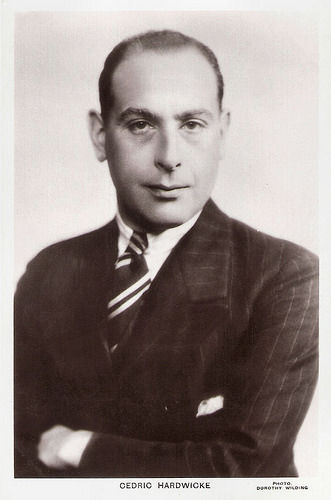
British postcard in the Picturegoer Series, London, no. 535. Photo: Dorothy Wilding.
Horatio Nelson and Alfred Dreyfus
Cedric Webster Hardwicke was born in Lye, Worcestershire, in 1893, to Dr Edwin Webster Hardwicke and his wife, Jessie (née Masterson). He attended Bridgnorth Grammar School in Shropshire, after which he intended to train as a doctor but failed to pass the necessary examinations.
He turned to the theatre and trained at the Royal Academy of Dramatic Art (RADA). In 1912, Hardwicke made his first stage appearance in Frederick Melville's melodrama The Monk and the Woman at the Lyceum Theatre, London. In 1913 he joined Benson's Company and toured in the provinces, South Africa and Rhodesia. In 1914 he appeared at the Old Vic as Malcolm in Macbeth, Tranio in The Taming of the Shrew, and the gravedigger in Hamlet.
WWI intervened in his career, and from 1914 to 1921 he served as an officer in the Judge Advocate's branch of the British Army in France. He was one of the last members of the British Expeditionary Force to leave France. Following his discharge, in January 1922 he joined the Birmingham Repertory Company, playing a range of parts from the drooping young lover Faulkland in The Rivals to the roistering Sir Toby Belch in Twelfth Night.
Hardwicke played many classical roles on stage, appearing at London's top theatres, making his name on the stage performing works by George Bernard Shaw, who said that Hardwicke was his fifth favourite actor after the four Marx Brothers. Hardwicke starred in such Shaw plays as Caesar and Cleopatra, Pygmalion, The Apple Cart, Candida, Too True to Be Good, and Don Juan in Hell.
He started to appear in film in 1926. He played Admiral Horatio Nelson in the silent biopic Nelson (Walter Summers, 1926) with Gertrude McCoy as Lady Hamilton. Five years later, he appeared as Capt. Alfred Dreyfus in a British film on the Dreyfus affair, Dreyfus (F.W. Kraemer, Milton Rosmer, 1931). He also appeared with Esther Ralston and Conrad Veidt in the thriller Rome Express (Walter Forde, 1932) and with Boris Karloff in the British horror film The Ghoul (T. Hayes Hunter, 1933).
On stage and in the cinema, he made such an impression that at age 41 he became the youngest actor to be knighted in the 1934 New Year's Honours. Other stage successes included The Amazing Dr. Clitterhouse, Antigone and A Majority of One, winning a Tony Award nomination for his performance as a Japanese diplomat.
In the cinema he had a hit with the historical drama Nell Gwynn (Herbert Wilcox, 1934) which portrays the historical romance between Charles II of England (Hardwicke) and the actress Nell Gwynn ( Anna Neagle ). He played in such films as Jew Süss/Power - Jew Suss (Lothar Mendes, 1934) based on Lion Feuchtwanger's novel Jud Süß, about Joseph Süß Oppenheimer played by Conrad Veidt , the American drama Les Misérables (Richard Boleslawski, 1935) and the British adventure film King Solomon's Mines (Robert Stevenson, 1937), starring Paul Robeson.
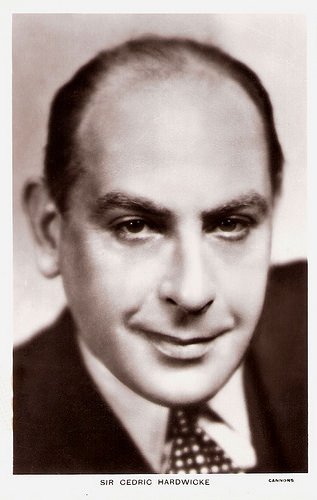
British postcard in the Picturegoer Series, London, no. 535a. Photo: Cannons.
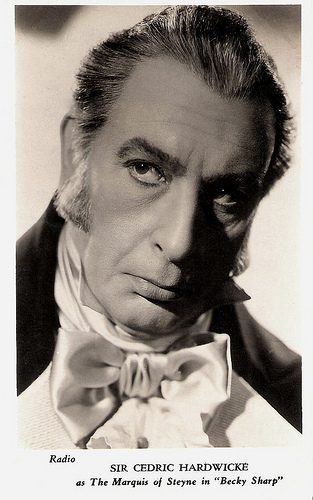
British postcard. Photo: Radio. Publicity still for Becky Sharp (Rouben Mamoulian, 1935).
David Livingstone and Ludwig von Frankenstein
In the late 1930s, Cedric Hardwicke moved to the US, initially for film work. He was in great demand in Hollywood. He played David Livingstone opposite Spencer Tracy's Henry Morton Stanley in Stanley and Livingstone (Henry King, 1939), and also played Frollo in The Hunchback of Notre Dame (William Dieterle, 1939). Then he played Mr Jones in a screen version of Joseph Conrad's novel Victory (John Cromwell, 1940).
He starred in The Ghost of Frankenstein (Erle C. Kenton, 1942), as the unfortunate Ludwig von Frankenstein, alongside Lon Chaney Jr. and Bela Lugosi . In the early 1940s he also continued his stage career, touring and in New York. In 1944 Hardwicke returned to Britain, again touring, and reappeared on the London stage, at the Westminster Theatre, on 29 March 1945, as Richard Varwell in a revival of Eden and Adelaide Phillpotts' comedy, Yellow Sands, and subsequently toured in this on the continent.
He returned to America late in 1945 and appeared with Ethel Barrymore in December in a revival of Shaw's Pygmalion, and continued on the New York stage the following year. In 1946, he starred opposite Katharine Cornell as King Creon in her production of Jean Anouilh's adaptation of the Greek tragedy Antigone. In 1948 he joined the Old Vic Company at the New Theatre to play Sir Toby Belch, Doctor Faustus, and Gaev in The Cherry Orchard. That year he also appeared in the British film The Winslow Boy (Anthony Asquith, 1948) and in Alfred Hitchcock's Rope (1948).
Then he moved permanently to the US. He was featured as King Arthur in the comedy/musical, A Connecticut Yankee in King Arthur's Court (Tay Garnett, 1949), singing Busy Doing Nothing in a trio with Bing Crosby and William Bendix. In 1951–1952, he appeared on Broadway in Shaw's Don Juan in Hell with Agnes Moorehead, Charles Boyer and Charles Laughton . Later, Hardwicke played in such films as Laurence Olivier 's Richard III (1955), and as the Pharaoh Seti I in Cecil B. DeMille's The Ten Commandments (1956).
On TV, he appeared in an episode of Alfred Hitchcock Presents entitled Wet Saturday (1956). During the 1961–1962 television season, Hardwicke starred as Professor Crayton in Gertrude Berg's sitcom Mrs. G. Goes to College. His final acting role was in The Outer Limits in the episode The Forms of Things Unknown.
In 1964, Cedric Hardwicke in New York from cancer. He was 71. He was married twice. In 1928, he married the English actress Helena Pickard. They divorced in 1948. Their son was actor Edward Hardwicke. His second marriage, which also produced one child and ended in divorce, was to Mary Scott, from 1950 to 1961.
Trailer The Ghost of Frankenstein (1942). Source: Movieclips Trailer Vault (YouTube).
Trailer Rope (1948). Source: thehotash1 (YouTube).
Sources: Wikipedia and .

British postcard in the Picturegoer Series, London, no. 535. Photo: Dorothy Wilding.
Horatio Nelson and Alfred Dreyfus
Cedric Webster Hardwicke was born in Lye, Worcestershire, in 1893, to Dr Edwin Webster Hardwicke and his wife, Jessie (née Masterson). He attended Bridgnorth Grammar School in Shropshire, after which he intended to train as a doctor but failed to pass the necessary examinations.
He turned to the theatre and trained at the Royal Academy of Dramatic Art (RADA). In 1912, Hardwicke made his first stage appearance in Frederick Melville's melodrama The Monk and the Woman at the Lyceum Theatre, London. In 1913 he joined Benson's Company and toured in the provinces, South Africa and Rhodesia. In 1914 he appeared at the Old Vic as Malcolm in Macbeth, Tranio in The Taming of the Shrew, and the gravedigger in Hamlet.
WWI intervened in his career, and from 1914 to 1921 he served as an officer in the Judge Advocate's branch of the British Army in France. He was one of the last members of the British Expeditionary Force to leave France. Following his discharge, in January 1922 he joined the Birmingham Repertory Company, playing a range of parts from the drooping young lover Faulkland in The Rivals to the roistering Sir Toby Belch in Twelfth Night.
Hardwicke played many classical roles on stage, appearing at London's top theatres, making his name on the stage performing works by George Bernard Shaw, who said that Hardwicke was his fifth favourite actor after the four Marx Brothers. Hardwicke starred in such Shaw plays as Caesar and Cleopatra, Pygmalion, The Apple Cart, Candida, Too True to Be Good, and Don Juan in Hell.
He started to appear in film in 1926. He played Admiral Horatio Nelson in the silent biopic Nelson (Walter Summers, 1926) with Gertrude McCoy as Lady Hamilton. Five years later, he appeared as Capt. Alfred Dreyfus in a British film on the Dreyfus affair, Dreyfus (F.W. Kraemer, Milton Rosmer, 1931). He also appeared with Esther Ralston and Conrad Veidt in the thriller Rome Express (Walter Forde, 1932) and with Boris Karloff in the British horror film The Ghoul (T. Hayes Hunter, 1933).
On stage and in the cinema, he made such an impression that at age 41 he became the youngest actor to be knighted in the 1934 New Year's Honours. Other stage successes included The Amazing Dr. Clitterhouse, Antigone and A Majority of One, winning a Tony Award nomination for his performance as a Japanese diplomat.
In the cinema he had a hit with the historical drama Nell Gwynn (Herbert Wilcox, 1934) which portrays the historical romance between Charles II of England (Hardwicke) and the actress Nell Gwynn ( Anna Neagle ). He played in such films as Jew Süss/Power - Jew Suss (Lothar Mendes, 1934) based on Lion Feuchtwanger's novel Jud Süß, about Joseph Süß Oppenheimer played by Conrad Veidt , the American drama Les Misérables (Richard Boleslawski, 1935) and the British adventure film King Solomon's Mines (Robert Stevenson, 1937), starring Paul Robeson.

British postcard in the Picturegoer Series, London, no. 535a. Photo: Cannons.

British postcard. Photo: Radio. Publicity still for Becky Sharp (Rouben Mamoulian, 1935).
David Livingstone and Ludwig von Frankenstein
In the late 1930s, Cedric Hardwicke moved to the US, initially for film work. He was in great demand in Hollywood. He played David Livingstone opposite Spencer Tracy's Henry Morton Stanley in Stanley and Livingstone (Henry King, 1939), and also played Frollo in The Hunchback of Notre Dame (William Dieterle, 1939). Then he played Mr Jones in a screen version of Joseph Conrad's novel Victory (John Cromwell, 1940).
He starred in The Ghost of Frankenstein (Erle C. Kenton, 1942), as the unfortunate Ludwig von Frankenstein, alongside Lon Chaney Jr. and Bela Lugosi . In the early 1940s he also continued his stage career, touring and in New York. In 1944 Hardwicke returned to Britain, again touring, and reappeared on the London stage, at the Westminster Theatre, on 29 March 1945, as Richard Varwell in a revival of Eden and Adelaide Phillpotts' comedy, Yellow Sands, and subsequently toured in this on the continent.
He returned to America late in 1945 and appeared with Ethel Barrymore in December in a revival of Shaw's Pygmalion, and continued on the New York stage the following year. In 1946, he starred opposite Katharine Cornell as King Creon in her production of Jean Anouilh's adaptation of the Greek tragedy Antigone. In 1948 he joined the Old Vic Company at the New Theatre to play Sir Toby Belch, Doctor Faustus, and Gaev in The Cherry Orchard. That year he also appeared in the British film The Winslow Boy (Anthony Asquith, 1948) and in Alfred Hitchcock's Rope (1948).
Then he moved permanently to the US. He was featured as King Arthur in the comedy/musical, A Connecticut Yankee in King Arthur's Court (Tay Garnett, 1949), singing Busy Doing Nothing in a trio with Bing Crosby and William Bendix. In 1951–1952, he appeared on Broadway in Shaw's Don Juan in Hell with Agnes Moorehead, Charles Boyer and Charles Laughton . Later, Hardwicke played in such films as Laurence Olivier 's Richard III (1955), and as the Pharaoh Seti I in Cecil B. DeMille's The Ten Commandments (1956).
On TV, he appeared in an episode of Alfred Hitchcock Presents entitled Wet Saturday (1956). During the 1961–1962 television season, Hardwicke starred as Professor Crayton in Gertrude Berg's sitcom Mrs. G. Goes to College. His final acting role was in The Outer Limits in the episode The Forms of Things Unknown.
In 1964, Cedric Hardwicke in New York from cancer. He was 71. He was married twice. In 1928, he married the English actress Helena Pickard. They divorced in 1948. Their son was actor Edward Hardwicke. His second marriage, which also produced one child and ended in divorce, was to Mary Scott, from 1950 to 1961.
Trailer The Ghost of Frankenstein (1942). Source: Movieclips Trailer Vault (YouTube).
Trailer Rope (1948). Source: thehotash1 (YouTube).
Sources: Wikipedia and .
Published on March 14, 2016 23:00
March 13, 2016
Hannelore Auer
Austrian Schlager singer Hannelore Auer (1942) appeared in several German-language comedies and Schlager films of the 1960’. She is married to another Schlager singer, Heino.
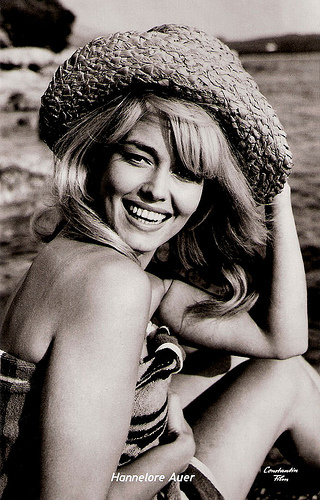
German postcard by Friedrich-W. Sander-Verlag, Minden/Westf., Kolibri, no. 2199. Photo: Constantin / Music House. Publicity still for Holiday in St. Tropez (Ernst Hofbauer, 1964).
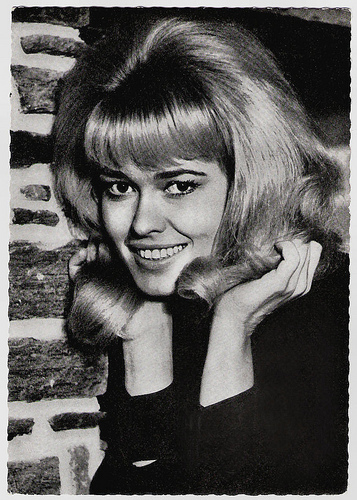
German postcard by Filmbilder-Vertrieb Ernst Freihoff, Essen, no. 917. Photo: Teldec / Winkler.
Kiss Me, Darling
Hannelore Auer was born in Linz, Austria in 1942 as the daughter of a postman. She visited the Federal trade school for fashion and commercial art in Linz for four years.
As a fifteen-year-old she took part in a singing contest in Vienna and won the second place with the titles Tausendmal möchte ich dich küssen (I want to kiss you a thousand times) and Fällt das gelbe Laub im Oktober (When the yellow leaves fall in October).
Shortly after, she signed her first record deal, and she started to appear in film comedies like Ich heirate Herrn Direktor/I Marry the Manager (Wolfgang Liebeneiner, 1960) starring Heidelinde Weis and Hans Söhnker , and Willy, der Privatdetektiv/Willy the Private Detective (Rudolph Schündler, 1960) a vehicle for popular comedian Willy Millowitsch.
Hannelore Auer had her biggest success in 1962 with the song Was in Athen geschah (What happened in Athens). Later she performed with Manfred Schnelldorfer as a duo and they had a hit with Kiss Me, Darling.
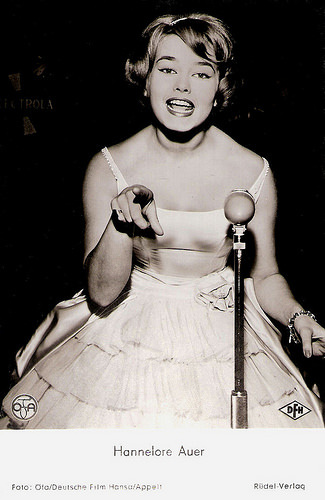
German postcard by Rüdel-Verlag, Hamburg-Bergedorf, no. 2967. Photo: Öfa / Deutsche Film Hansa / Appelt. Publicity still for Ich heirate Herrn Direktor/I'm getting married Mr Director (Wolfgang Liebeneiner, 1960).
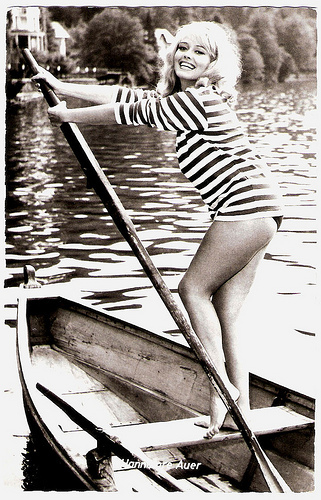
German postcard by Friedrich-W. Sander-Verlag, Minden/Westf., Kolibri, no. 2550.
Schickeria
During the early 1960s, Hannelore Auer was romantically involved with film director Franz Antel and he gave her several supporting roles in his film comedies. She played with Günther Philipp in Das ist die Liebe der Matrosen/This is the love of the sailors (Franz Antel, 1962). In many of these films she only appeared briefly as a singer.
She continued to work with other directors such as in Ich bin auch nur eine Frau/I, Too, Am Only a Woman (Alfred Weidenmann, 1962) starring Maria Schell , Schwejks Flegeljahre/Schweik's Years of Indiscretion (Wolfgang Liebeneiner, 1963) featuring Peter Alexander , and Holiday in St. Tropez (Ernst Hofbauer, 1964).
In the second half of the 1960s, she also worked often for TV, but she continued to play in such mediocre films like Susanne, die Wirtin von der Lahn/The Sweet Sins of Sexy Susan (Franz Antel, 1967) starring Hungarian actress Teri Tordai and French Pascale Petit , and the Italian-German coproduction Kommissar X - Drei blaue Panther/Three blue panthers (Gianfranco Parolini, 1968) starring the Italian Tony Kendall.
Auer became a part of the so-called Schickeria (in-crowd) and the tabloids were more interested in her private life than in her songs or her film roles. In 1968 she refused a marriage proposal by Franz Antel, and became the second wife of the Austrian prince Alfred ‘Alfie’ Auersperg. Then her film career stopped. She had a serious accident with her sports car in 1972 which nearly killed her.
After her divorce from Auersperg in 1979, she married the popular German Schlager singer Heino (Heinz Georg Kramm). She became his manager and performed with him, for example as a co-host of the popular music show Heino und Hannelore (Heino and Hannelore). In 2004 Hannelore Kramm suffered a heart attack. This was one of the reasons that Heino interrupted his career.
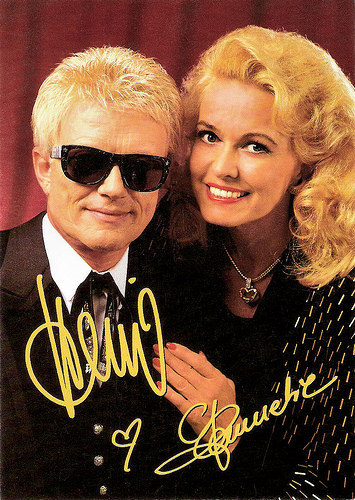
With Heino. German autograph card by Büro Heino, Bad Münstereifel. Photo: Christian Altengarten, Brühl. Design: Martinez, Köln.
Hannelore Auer sings with The Rackets Wer ist der Boy ohne Namen? in the TV show Hotel Victoria (1965). Source: Rarely Played (YouTube).
Hannelore Auer sings Amore addio in Tausend Takte Übermut (1965) with Rex Gildo . Source: Fritz51265 (YouTube).
Sources: Wikipedia (German), and .

German postcard by Friedrich-W. Sander-Verlag, Minden/Westf., Kolibri, no. 2199. Photo: Constantin / Music House. Publicity still for Holiday in St. Tropez (Ernst Hofbauer, 1964).

German postcard by Filmbilder-Vertrieb Ernst Freihoff, Essen, no. 917. Photo: Teldec / Winkler.
Kiss Me, Darling
Hannelore Auer was born in Linz, Austria in 1942 as the daughter of a postman. She visited the Federal trade school for fashion and commercial art in Linz for four years.
As a fifteen-year-old she took part in a singing contest in Vienna and won the second place with the titles Tausendmal möchte ich dich küssen (I want to kiss you a thousand times) and Fällt das gelbe Laub im Oktober (When the yellow leaves fall in October).
Shortly after, she signed her first record deal, and she started to appear in film comedies like Ich heirate Herrn Direktor/I Marry the Manager (Wolfgang Liebeneiner, 1960) starring Heidelinde Weis and Hans Söhnker , and Willy, der Privatdetektiv/Willy the Private Detective (Rudolph Schündler, 1960) a vehicle for popular comedian Willy Millowitsch.
Hannelore Auer had her biggest success in 1962 with the song Was in Athen geschah (What happened in Athens). Later she performed with Manfred Schnelldorfer as a duo and they had a hit with Kiss Me, Darling.

German postcard by Rüdel-Verlag, Hamburg-Bergedorf, no. 2967. Photo: Öfa / Deutsche Film Hansa / Appelt. Publicity still for Ich heirate Herrn Direktor/I'm getting married Mr Director (Wolfgang Liebeneiner, 1960).

German postcard by Friedrich-W. Sander-Verlag, Minden/Westf., Kolibri, no. 2550.
Schickeria
During the early 1960s, Hannelore Auer was romantically involved with film director Franz Antel and he gave her several supporting roles in his film comedies. She played with Günther Philipp in Das ist die Liebe der Matrosen/This is the love of the sailors (Franz Antel, 1962). In many of these films she only appeared briefly as a singer.
She continued to work with other directors such as in Ich bin auch nur eine Frau/I, Too, Am Only a Woman (Alfred Weidenmann, 1962) starring Maria Schell , Schwejks Flegeljahre/Schweik's Years of Indiscretion (Wolfgang Liebeneiner, 1963) featuring Peter Alexander , and Holiday in St. Tropez (Ernst Hofbauer, 1964).
In the second half of the 1960s, she also worked often for TV, but she continued to play in such mediocre films like Susanne, die Wirtin von der Lahn/The Sweet Sins of Sexy Susan (Franz Antel, 1967) starring Hungarian actress Teri Tordai and French Pascale Petit , and the Italian-German coproduction Kommissar X - Drei blaue Panther/Three blue panthers (Gianfranco Parolini, 1968) starring the Italian Tony Kendall.
Auer became a part of the so-called Schickeria (in-crowd) and the tabloids were more interested in her private life than in her songs or her film roles. In 1968 she refused a marriage proposal by Franz Antel, and became the second wife of the Austrian prince Alfred ‘Alfie’ Auersperg. Then her film career stopped. She had a serious accident with her sports car in 1972 which nearly killed her.
After her divorce from Auersperg in 1979, she married the popular German Schlager singer Heino (Heinz Georg Kramm). She became his manager and performed with him, for example as a co-host of the popular music show Heino und Hannelore (Heino and Hannelore). In 2004 Hannelore Kramm suffered a heart attack. This was one of the reasons that Heino interrupted his career.

With Heino. German autograph card by Büro Heino, Bad Münstereifel. Photo: Christian Altengarten, Brühl. Design: Martinez, Köln.
Hannelore Auer sings with The Rackets Wer ist der Boy ohne Namen? in the TV show Hotel Victoria (1965). Source: Rarely Played (YouTube).
Hannelore Auer sings Amore addio in Tausend Takte Übermut (1965) with Rex Gildo . Source: Fritz51265 (YouTube).
Sources: Wikipedia (German), and .
Published on March 13, 2016 23:00
Paul van Yperen's Blog
- Paul van Yperen's profile
- 13 followers
Paul van Yperen isn't a Goodreads Author
(yet),
but they
do have a blog,
so here are some recent posts imported from
their feed.



